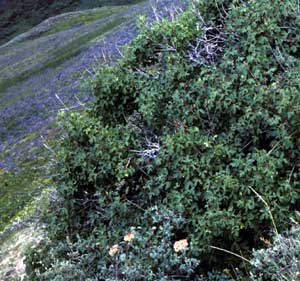
(Rocky Mountain Maple)
[Torr.]
Subclass: Rosidae
Order: Sapindales
Family: Aceraceae
Family Description: Maple
Key Characteristics:
| Shrub or small tree; 3-10 meters tall; reddish new branchlets; old bark is grayish. (Rocky Mountain Maple or Douglas Maple) | ||
|
leaves
|
flowers
|
fruit
|
|
|
|
General Description:
Large shrub or small tree usually found above 5000' elev. on north slopes or more moist sites. Trunks are usually in a clump and vary from ½ inch to 5 inches in diameter and grow from 6 to 30 feet tall.
The flowers are about the size of a dime, yellowish in color, not showy, may be unisexual or bisexual in the same cluster. Flowers may have petals which look like the sepals or have no petals. Some plants have only one sex per plant (dioecious) while others have both sexes on the same plant (monoecious).
The 2-winged, u-shaped fruits (samaras) are eaten by squirrels and rodents. The wings usually form an angle of < 90 degrees.
Can be recognized by: 1. 3- to 5- lobed, 3-5" leaves (sometimes trifoliate) with many pointed (rather than rounded) teeth. 2. Leaves turn yellow in the fall.
Distribution:
Alberta to British Columbia south to New Mexico and California, thus throughout Idaho.
Habitat:
Mountains; Frequently near water or in ravines.
Other:
Young shoots were utilized by Native Americans like asparagus.
Important State References:
No information available at this time
Photos and Information written by Dr. Karl E. Holte,© 2002
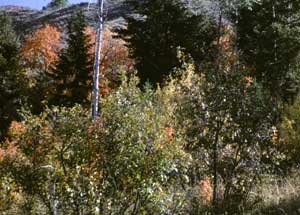
(Bigtooth Maple)
[Nutt.]
Subclass: Rosidae
Order: Sapindales
Family: Aceraceae
Family Description: Maple
Key Characteristics:
| Large shrub or small tree; up to 15 M tall; brown twigs and branches. (Bigtooth Maple, Wasatch Maple) | ||
|
leaves
|
flowers
|
fruit
|
|
|
|
General Description:
Large shrub or usually a small tree which grows on moist canyon sides, along streams or in ravines which are surrounded by sage brush. Extra large specimens may grow to 50 feet tall and 1 foot in diameter.
The apetalous flowers are about the size of a dime, yellowish in color, not showy, and are bisexual.
The 2-winged, u-shaped fruits form an angle of about 120 degrees. These are eaten by rodents.
Can be recognized by:
1. Three lobed leaves with blunt or rounded teeth and sinuses.
2. Leaves turn reddish-orange in the fall.
Distribution:
Montana to Idaho, south to Texas and Arizona.
Habitat:
H ills, ravines, sometimes along streams.
Other:
The trunks can be tapped for syrup.
Important State References:
No information available at this time
Photos and Information written by Dr. Karl E. Holte,© 2002
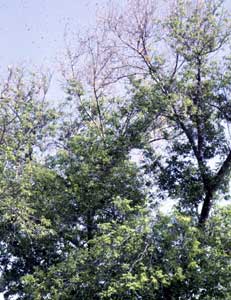
(Box Elder)
[L.]
Subclass: Rosidae
Order: Sapindales
Family: Aceraceae
Family Description: Maple
Key Characteristics:
| Tree grows up to 20 M tall; compound leaves (usually 3 leaflets, but can be up to 7) | ||
|
leaves
|
flowers
|
fruit
|
|
|
|
General Description:
A dioecious, rapidly growing tree, up to 70 feet tall, often cultivated, found along streams in high canyons and foothills. Its trunks may reach 4 feet in diameter. Its opposite, compound, 6-15 inch leaves commonly have 3 leaflets, but cultivated forms may have 5 or 7 leaflets.
The axillary clusters of unisexual flowers lack petals. The pistillate flowers have a nectiferous disc between the pistil and 4-5 sepals. The male flowers have 4-5 stamens and sepals.
Distribution:
One variety interior (Britt.) Sarg. North Dakota to Idaho south to New Mexico and Arizona. The species is said to be native to every state in the U.S. except possibly Florida.
Habitat:
Along streams of hills, in disturbed areas, planted in windbreaks and yards.
Other:
As in all maples, these trees can be tapped for making syrup and sugar.
Important State References:
No information available at this time
Photos and Information written by Dr. Karl E. Holte,© 2002
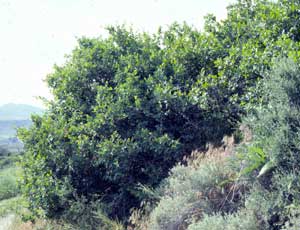
(Skunkbush)
[Nutt.]
Subclass: Rosidae
Order: Sapindales
Family: Anacardiaceae
Family Description: Sumac
Key Characteristics:
| Shrub; 1-2 ½ M tall; flowers before leaf formation; Also known as: Lemonade sumac, Smooth sumac, Squawbush. |
||
|
leaves
|
flowers
|
fruit
|
|
|
|
|
leaflets
|
||
|
||
General Description:
These are rounded shrubs up to 7 feet tall. The young twigs are puberulent. The terminal, fan-shaped leaflet is about twice as large as two lateral ones of the trifoliate leaves. The flowers appear before the leaves in the spring. The yellow 1/8 inch long flowers are in ½ inch clusters at the end of twigs. The resinous, reddish drupes can be brewed to make a lemonade tasting drink, eaten raw or cooked, or ground to make cakes which could be dried for future use. Native Americans split the twigs for making basketry. The leaves were sometimes used as a tobacco substitute or mixed with tobacco. The bark was also used to make baskets.
Distribution:
North Dakota to Washington, south to Texas and California
Habitat:
Along streams, wet places, cracks in lava.
Other:
Fruits are edible, fruits can be steeped to make a lemonade like drink
Important State References:
No information available at this time
Photos and Information written by Dr. Karl Holte, 2002
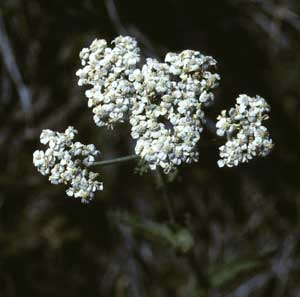
(Common Yarrow)
[L.]
Subclass: Asteridae
Order: Asterales
Family: Asteraceae
Family Description: Aster (Sunflower)
Key Characteristics:
| Aromatic, rhizomatous, perennial herbs. | ||
|
leaves
|
flowers
|
fruit
|
|
|
|
General Description:
This perennial 1-3 feet tall, European plant has fern-like leaves which are stalked near the base, but sessile higher on the stem. It is easily recognized by its odor when crushed. The white flowersare arranged in flat-topped corymbs. Actually what appears to be a flower is a small head of two kinds of flowers. The ones in the center of each head are symmetrical disc flowers, while the outer ray flowers are white. The above ground stems are attached to underground, reddish rhizomes.
Distribution:
Introduced from Eurasia. One variety, lanulosa Nutt. is native to the U. S.
Habitat:
Disturbed areas which have partially recovered such as older roadsides, grazed meadows, etc.
Other:
Common Yarrow has many uses and is said to contain more than 120 compounds including achilleine, coumarin, cyanidin, azulene, thujone (which is considered to be toxic) & salicylic acid. Achilleine is said to stop bleeding and may suppress menstruation. Tea made from the leaves can be used as a douche, relieve heavy menstruation, a tonic for the heart and circulatory system, lowering blood pressure, slowing heart beat, as a diaphoretic, anti-inflammatory and to counteract infection. Native Americans also used dried, powered leaves to stop bleeding and to put on bruises, burns, earaches and arrow wounds. In an emergency, the leaves can be chewed and put on bleeding wounds. More recent use is dry the leaves and smoke it for a mild euphoric effect.
Important State References:
No information available at this time
Photos and Information written by Dr. Karl E. Holte,© 2002
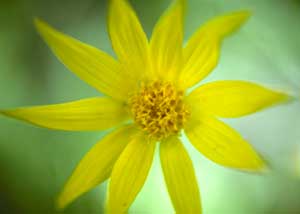
(Heart-leaf Arnica)
[Hook.]
Subclass: Asteridae
Order: Asterales
Family: Asteraceae
Family Description: Aster (Sunflower)
Key Characteristics:
| Rhizomatous perennial from long, branched rhizomes. | |||
|
stems
|
leaves
|
flowers
|
fruit
|
|
|
|
|
General Description:
This perennial is usually less than 1 foot tall including the flower stalk. It spreads into large patches by lateral root growth. It has heart-shaped, serrated, opposite leaves which are mostly basal. The plant grows under conifers, usually douglas fir or lodgepole pine. The showy, yellow flower heads are about 2 ½ inches in diameter.
Distribution:
Alaska to Saskatchewan to New Mexico and California to northern Michigan
Habitat:
Mostly in moist woodlands in shade from low to high elevations
Other:
The constituents of the genus Arnica are varied depending upon which part of the plant one is describing. The above ground parts contain volatile oils and the roots contain resins. Fatty acids and aromatics, including thymol, thymohydroquinone, arnicin, arnidendiol, arnidoiol, arnisterin, many carotinoids and flavonoids. They tend to lack toxic alkaloids.
Flowers are most commonly used, but all parts of the plants contain active ingredients. Tincture , oil, salve, tea or bruised fresh plant parts are used for bruises, hyperextensions, arthritis, bursitis, and myalgia. It is said to work by stimulating and dilating capillaries.
References:
Medicinal Plants of the Pacific West by Michael Moore.
Photos & Information written by Dr.Karl E. Holte,© 2002
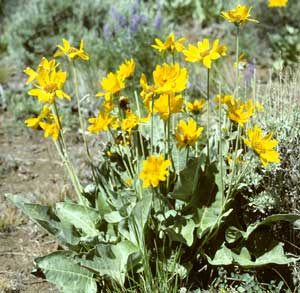
(Arrowleaf Balsamroot)
[(Pursh) Nutt.]
Subclass: Asteridae
Order: Asterales
Family: Asteraceae
Family Description: Aster (Sunflower)
Key Characteristics:
| The entire plant has a grayish appearance due to a covering of a felt-like tomentum of short trichomes. The long petioles terminating in a wooly triangular, sagittate leaf blade are good identifying characters. | ||
|
leaves
|
flowers
|
fruit
|
|
|
|
General Description:
This large-leaved spring flowering, showy plant is commonly found anywhere Big Sage grows. Larger plants have many heart-shaped, long petioled, basal, gray green, hairy leaves and numerous flower stalks. It usually grows at lower elevations than Mule's Ears. Arrowleaf balsamroot has naked or one bracted flower stems while Mule's Ears has leafy flower stems. The flower heads are very similar for the two species.
Similar Species:
Mule's Ears.
Distribution:
Lowlands to mid elevations in mountains from southern British Columbia to southern California east tp Montana, the Black Hills of South Dakota and Colorado.
Habitat:
Open hillsides and flat lands, usually in deep soils in valleys and up to moderate elevations in the mountains.
Other:
The above ground parts contain flavonoids, 6-hydroxy-kaempferol, 7-methyl-ether, and the root resins contain terebinthine , inulin, heterotetragylcans and conjugated caffeic acids. It is used as a disinfectant-expectorant, for sore throats, and pulmonary disorders. Powdered leaves can be used as a poultice on mild burns, skin sores and ulcerations and skin infections. It is also reported to be an immunostimulant, thus increasing white blood cell activity.
The two to 4 foot long taproots were used as an emergency food by the Native Americans. The seeds can be dried, roasted eaten whole or ground (including the shell) and added to pancakes, muffins, breads and cereals.
Important State References:
No information available at this time.
Photos & Information written by Dr. Karl E. Holte,© 2002
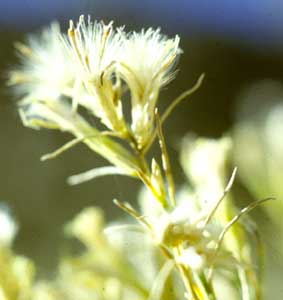
(Gray or Common Rabbit-brush)
[(Pall.) Brit.]
Subclass: Asteridae
Order: Asterales
Family: Asteraceae
Family Description: Aster (Sunflower)
Key Characteristics:
| Branching shrub of dry areas. Twigs flexible, covered with felt-like persistent tomentum. Flowers in the fall. No ray flowers. Highly variable. | ||
|
leaves
|
flowers
|
fruit
|
|
|
|
General Description:
This fall-blooming, up to 4 foot tall shrub has twigs which due to a covering of hair appear gray-green. It has narrow, almost grass-like gray-green leaves. It is common among sage brush, along roadsides, steam banks, and after fires. It has clusters of yellow flowers, usually in September which are followed by whitish tufts of pappus. It has a sweetish, resinous smell, aromatic with an almost pine-like odor.
Distribution:
British Columbia to Alberta, south to Texas and northern Mexico.
Habitat:
Moderately alkaline, dry, open slopes at moderate to low elevations, often in slightly disturbed areas with sagebrush or in vacant lots.
Other:
Favorite food of white-tailed and black-tailed jackrabbits. The name means golden shrub. Native Americans chewed the bark and wood for a chewing gum and used a teas wash for skin sores. Fresh and dried flowers can be used as a dye–gold colors with mordants of alum, copper or tin or chrome for a rust color, or iron for green color. From the fall flowers, bees make a strong-flavored, amber-colored honey.
Important State References:
No information available at this time.
Photos & Information written by Dr. Karl E. Holte,© 2002
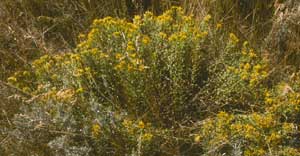
(Green Rubber Rabbit-brush )
[(Hook.) Hall]
Subclass: Asteridae
Order: Asterales
Family: Asteraceae
Family Description: Aster (Sunflower)
Key Characteristics:
| One meter high or less shrub with glabrous, brittle twigs; no ray flowers; flowers in the fall | ||
|
leaves
|
flowers
|
fruit
|
|
|
|
General Description:
This fall-blooming, up to 4 foot tall shrub is also found in undisturbed sage brush sites. It differs from Gray Rabbit-brush by having flat, twisted leaves. Its flowers are in small, yellow heads which are followed by feathery-appearing heads caused by the capillary pappus.
Distribution:
Southern British Columbia to California east of the Cascades to North Dakota and south to New Mexico.
Habitat:
Dry, open places in valleys, plains, and foothills up to moderate elevations in the mountains.
Other:
Usually found in less disturbed areas than Gray Rabbit-brush with sagebrush, increases with grazing.
A yellow dye can be made from the flowers and leaves.
Important State References:
No information available at this time
Photos and Information written by Dr. Karl E. Holte,© 2002
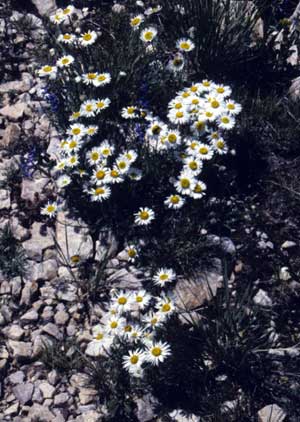
(Daisy)
Subclass: Asteridae
Order: Asterales
Family: Asteraceae
Family Description: Aster (Sunflower)
Key Characteristics:
|
Blooms in spring; heads almost always radiate (one of our species is not); annual, biennial or perennial herbs with alternate cauline leaves (sometimes all basal); involucral bracts usually in one series, imbricate, chartaceous with green midrib and tip; stylar appendage less than ½ mm stylar appendage usually greater than ½ mm. |
||
|
leaves
|
flowers
|
fruit
|
|
|
|
General Description:
There are many species of this Aster-like genus. Most are perennials. The flower heads have many ray flowers which can be violet, purple, pinkish, white or blue. There are even some with bright yellow ray flowers. Asters bloom in the fall and have heads with imbricate involucral bracts (phyllaries) subtending the ray flowers. Daisies bloom in the spring and have heads commonly with only one whorl of bracts. One species Erigeron canadensis syn. Conyza canadensis which is a native of North America was introduced into Europe in the 17th Century and became a troublesome weed. Fleabane plants were believed to drive away fleas, thus the common name. The small seeds supposedly looked like fleas. The name Erigeron does not imply medicinal properties but comes from the Greek words eri (=early) and geron (= aged person ) and refers to the "worn-out" appearance of some of the species in the genus. It is still used by herbalists. No reference was found on current uses in America either old or new of this genus. The oils of this genus contain limonene and terpineol as well as tannins and choline. Thus, it has astringent, diuretic and hemostatic affects.
Similar Species:
Aster flowers.
Distribution:
Wide.
Habitat:
Almost all habitats.
Other:
Leaves of some species have been used as a tea to alleviate kidney problems. The whole plants are gathered and dried or sometimes only the fruits are used. The constituents contain a bitter extractive, tannic and gallic acids and a volatile oil. It acts as an astringent, diuretic tonic. It is considered useful in gravel, diabetes, dropsy and many kidney diseases and is also used to alleviate diarrhea and dysentery. The oil of Erigeron resembles oil of Turpentine, but is less irritating. It has been used to stop hemorrhage from the lungs or alimentary tract in the past. It was once also used to alleviate inflamed tonsils and sore throats.
Important State References:
No information available at this time
Photos and Information written by Dr. Karl E. Holte,© 2002
(Broom Snakeweed)
[(Pursh) Britt. & Rusby.]
Subclass: Asteridae
Order: Asterales
Family: Asteraceae
Family Description: Aster (Sunflower) Matchbrush
Key Characteristics:
| Shrub 2-6 dm tall Numerous erect, slender, brittle branches. Has ray flowers in each head | ||
|
leaves
|
flowers
|
fruit
|
|
|
|
General Description:
This yellow-flowered, bushy plant varies in height from 8 inches to 2 feet. It is commonly found in dry sites with sage brush below the subalpine zone. It seems to increase with over use of the range. It can be confused with gray rabbit-brush, but broom snakeweed has ray flowers and Rabbit-brush does not. The imbricate involucral bracts are green-tipped. The herbage and linear leaves are scabrous, punctate, puberulent. The leaves are 2-4 cm long and 1-2 mm wide. The flowers are in small, flat-topped, sub-cylindric heads. The pappus is of 3-8 scales rather than hairs. Herbalists use the dried, bundled flowering stems boiled in water to make a tea which is then added to one's bath to ease the pains of arthritis and muscle aches.
Distribution:
Sask. and Alberta to extreme southeast Washington, eastern Oregon, California, Mexico and Kansas.
Habitat:
Dry, open places in the lower foothills, valleys, and plains to higher elevations the farther south in its range
Other:
Flowering stems were bundled dried and used later for tea that was added to a bath that was reported to ease arthritis and muscle-tendon pain.
Important State References:
No information available at this time
Photos and Information written by Dr. Karl E. Holte,© 2002
gray horse-brush, spineless horse-brush Aster (Sunflower) Asteraceae Tetradymia canescens DC
This spring blooming, yellow-flowered, gray tomentose, up to 3 foot tall shrub grows in dry, open places in the foothills. The twigs are densely hairy with less hairy areas beneath each leaf. The 6 to 10 mm long, somewhat cylindric , alternate leaves are closely appressed to the twigs. Clusters of 1 cm long secondary, smaller leaves are in the axils of the 1-3 cm long primary leaves. The flower heads are subtended by 4, rarely 5 thin-margined bracts. There are usually 4 yellow flowers in each head, thus the name Tetradymia (tetra = 4).
Apparently all species of this genus are poisonous to livestock. They produce liver injury in sheep and sensitivity of the skin to sunlight. Symptoms of anorexia, depression, twitching, incoordination, rapid, weak pulse, prostration, dyspnea, coma appear after about 16 hours and cause death within an hour after symptoms appear. Losses of more than 1000 animals in a band are known to occur, especially in the spring when it is one of the few plants with green leaves. Tests have not shown it to be poisonous to cattle, but has been reported to be toxic to horses.
Tetradymia canescens DC. Gray Horse-brush, Asteraceae Sunflower Family
Spineless Horse-brush
CHARACTERISTICS
Unarmed, much-branched shrub 2-5 dm tall
Leaves, involucres, and twigs conspicuously and closely white-tomentose
LEAVES
primary leaves linear or oblanceolate 1-3 cm long& 1-4 mm wide
sometimes bearing axillary fascicles of shorter and proportionately broader leaves
conspicuously, closely, white tomentose
FLOWERS
4 in each head
heads in small cymose clusters terminating the numerous short branches
involucre 7-10 mm high of 4 or sometimes 5 bracts
pappus of numerous white or whitish capillary bristles
FRUIT
densely hairy (rarely glabrous) achenes
HABITAT
dry, open places in foothills and plains
DISTRIBUTION
Southwest Montana and Central Idaho to Oregon and Nevada
OTHER
creeping oregongrape, low oregongrape Barberry Berberidaceae Berberis repens Lindl.
This low growing, creeping plant appears at first to be an herb, but is actually a shrub with compound, evergreen leaves with 5 or 7 leaflets. Each leaflet is similar to a holly leaf with spines all along its margins. The leaves often turn a beautiful maroon in the fall and winter. The plant spreads by underground branching, thus what appears to be a dozen plants is actually only one plant. It is rarely over 30 cm (12 inches tall). The upper leaves tend to be ascending from the short woody stem which is terminated by a raceme of yellow flowers. The fruits are waxy blue and are grape-like. The fruits are somewhat sour with an alum affect when eaten fresh. The flowers are excellent if sauted and added to batter for muffins or pancakes. The fruits also make a nice addition to muffins or pancakes. Native Americans used the entire plant to make a dulled greenish yellow dye. Alum was used as a mordant. The boiled bark from the roots makes a brilliant yellow dye. Flathead and Kootenai Indians mashed the berries in a bowl and added milk and sugar for a very tasty desert. The berries can also be used to make jams, jellies, and wine. An alkaloid, berberine, has been found to stimulate involuntary muscles. Flathead Indians also used the plant as an antiseptic to clean wounds and cuts. It was also used to treat gonorrhea and syphilis. Also it was used as a diuretic, for stomach troubles, as a contraceptive, to treat rheumatism and as an appetite stimulant. The National Standard Dispensatory lists other uses as a tonic, stimulant, antiperiodic, and antiscorbutic, and as a treatment for dyspepsia, diarrhea, dysentery, psoriasis, eczema, and chronic uterine diseases but warns that overuse can be fatal.
Berberis repens Lindl. Creeping or Low Oregon-grape Berberidaceae Barberry Family
CHARACTERISTICS
Low growing shrub with yellow wood and coriaceous, evergreen and prickly edged leaflets
1.5-8 dm tall, arising from long, branching rootstocks
LEAVES
Pinnately compound with 5-7, spinulose margined, coriaceous leaflets
glossy or dull on upper surface, always dull and glaucous on lower surface
lower surface covered with minute papillae
FLOWERS
Perianth (sepals and Petals) of 4or 5 whorls of 3 distinct members each, the outer 1-2 series often deciduous and bractlike. Sepals and petals apparently 6 each, alike or dissimilar
the inner series of petals often glandular at base.
stamens as many as petals and opposite them or fewer or more
anthers opening by 2 uplifting valves
FRUIT
a one carpellary, 1- celled, 1-several seeded berry
HABITAT
foothills to lower montane, often in talus slopes
DISTRIBUTION
Eastern Washington south, east of the Cascades to northeast California east to Alberta, Sought Dakota, south to Texas, New Mexico, Utah and Nevada
OTHER
Flowers can be sauted and put into muffins, pancakes, etc.
Fruits can be made into juice, jam, jelly and wine.
It can be used as a bitter tonic for impaired salivary and gastric secretions, as a stimulant to liver and skin protein metabolism and as an antimicrobial for skin and intestinal tract. It is said to aid digestion and absorption of food. It can be used to alleviate psoriasis.
Photos and content written by Karl Holte, 2002
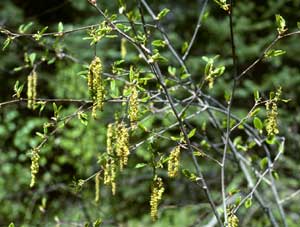
Wavy-leaved or Sitka Alder Birch Betulaceae Alnus sinuata (Regel) Rydb.
These are sweet-scented shrubs mostly 2-4 meters tall. Young bark is reddish brown, glandular dotted, but glabrous. The older bark is grayish-black. The alternately arranged, ovate leaves vary from 3 to 10 cm long. The base is rounded or cordate, but the apex is acute to slightly acuminate. The margins vary from serrate-denticulate to strongly sinuate. The upper surface is glabrous, but the lower surface varies from hairy overall to hairy on only the veins. Both male and female catkins originate on the current year's growth. The pistillate catkins are 3-6 per branch. The staminate catkins may grow as long as 10 cm. The fruits have thin, broad, membranous wings which are usually more than twice as wide as the nutlet.
Alnus sinuata (Regel) Rydb. Sitka Alder, Wavy-leaved Alder Betulaceae Birch Family
CHARACTERISTICS
shrubs commonly 4-5 , sometimes up to 8 meters tall
bark reddish brown, then becoming gray-black
young growth covered by non-stipitate glands
Unisexual flowers always in unisexual catkins which develop with the leaves on growth of current year
new twigs generally glabrous
pollen flowers always in pendant catkins
the main bracts subtend 2 smaller bracts which subtend 3-6 flowers
each flower contains 3-4 stamens surrounded by a 4-parted perianth
pistillate flowers are in cone-like catkins because the scales are hardened and persistent
each hardened scale subtends 2 naked flowers which are subtended by 2 or 3 small bracts
LEAVES
ovate, 3-10 cm long, acute to sub-cordate at base, acute apex; margins finely once or twice serrulate, usually sinuate; only slightly paler beneath, hairy on veins or over entire surface, upper surface usually glabrous.
FLOWERS
develop on current years growth. Staminate catkins up to 10 cm long
the pistillate flowers 3-6 on the same branch in catkins up to 1.5 cm long and less than 1 cm in diameter, each catkin borne on a stalk 2-3 times as long as the catkin.
FRUIT
with a thin membranous wing at least ½ as broad as the nutlet
HABITAT
moist woods, streambanks, margins of ponds, open montane slopes up to timberline
DISTRIBUTION
Alaska south to the Cascades and Washington Olympic Mountains, through western Oregon to mountains of northern California, north central and eastern Washington, Montana and Idaho in the Rocky mountains of Colorado.
OTHER
too small to of much economic use except for firewood. Dried leaves and bark were sometimes used to make a decoction for a simple tea and for external washes. It is astringent, mildly heating and could also be used to “tone” the small intestinal lining for better food absorption and to aid in fat metabolism.
Even small alders are being utilized in Canada. They are making shavings of the trunks of both alder and quaking aspen. These are glued together into sheets called Oriented Strand Board (OSB) which are used for sub-flooring, sub-roofing, sheeting on houses and for making I beams that are used for rafters, non-squeaking floor joists and many other uses. The American lumbering industry has not yet begun manufacturing OSB.
Photos and content written by Karl Holte, 2002
(Red Alder)
[Bong.]
Subclass: Hammamelidae
Order: Fagales
Family: Betulaceae
Family Description: Birch
Key Characteristics:
| Trees up to 25 meters tall; new twigs generally glabrous | ||
|
leaves
|
flowers
|
fruit
|
|
|
|
General Description:
This rapidly growing tree can reach 25 feet tall with up to an 8 inch diameter trunk. The bark is thin, gray, and smooth. The wood tends to turn a deep red. The alternately arranged leaves are elliptic, 5-15 cm long with acute bases and apexes, and revolute, irregularly serrate margins. The upper glabrous surface is deep green while the lower surface is rusty gray, hairy and glandular-dotted. The catkins flower while the leaves are developing. They are on previous season's growth. Male catkins are 5-12 cm long and drooping. The female catkins are woody, about 1 ½ to 2 cm long, and bear winged fruits on their upper surface. They grow in moist woods, often along streams in Northern Idaho. The wood is used mostly for burning, but is also made into attractive hardwood furniture. Also known as Oregon Alder.
Distribution:
Alaska southward , west of the Cascades to California and in Northern Idaho.
Habitat:
Grows in moist woods, mostly below 1000 feet elevation.
Other:
Sometimes considered a weedy species useful only for firewood, but recently has been utilized for furniture building. The cones have also been gold plated and sold as “pine cones.”
Important State References:
No information available at this time
Photos and Information written by Dr. Karl E. Holte,© 2002

Water, Spring, Red, Paper Birch Birch Betulaceae Betula occidentalis Hook.
This often many-trunked shrub or small tree may attain heights commonly up to 8 meters tall. The young, often pubescent twigs bear abundant, conspicuous crystalline glands. The older bark varies from dull gray to coppery brown to reddish-brown. It has conspicuous lenticels oriented perpendicular to the length of the branches. The leaf blades vary from glabrous to pubescent, often with tufts of hairs in the axils of the veins on the lower surface. The 2 ½ to 4.5 cm long leaves vary from having rounded bases and apices to being slightly acute. The margins are usually sharply, doubly serrate. At maturity the pistillate catkins are 2-4 cm long and droop. The membranous wings on the pubescent fruits are about equal in width. The drooping, cylindrical staminate catkins are 3 to 6.5 cm long. Many people have an allergy to the pollen. The copious sap can be harvested in the spring and made into syrup. Its sugar content is not as high as that of maples. The inner bark can be dried and ground into flour in emergencies. One can also cut the inner bark into strips and boil to eat like noodles or simply eat them raw. The young twigs can also be boiled to make a tea. Oil of wintergreen comes from birches.
Betula occidentalis Hook. Water, Spring, Red, or Paper Birch Betulaceae Birch Family
CHARACTERISTICS
A small tree or many trunked shrub up to 10 m tall, each up to 4 dm in diameter
young twigs are covered by resinous, crystaline glands which gives them a rough appearance and may also be covered by pubescence
trunks are different from other species in that they have lenticels oriented perpendicular to their length on the coppery, dark reddish, or reddish-brown or gray, smooth, non-peeling bark
LEAVES
ovate to obovate leaf blades can be either glabrous or pubescent, but usually glandular, 2-4.5 cm long the apex varies from rounded to acute and the leaf base is ordinarily rounded, but sometimes is slightly acute the leaf margins are once or twice sharply serrate
FLOWERS
pistillate catkins are 2-4 cm long and 4-10 mm in diameter with protruding ciliate, puberulent bractlets.
The catkins disintegrate when the fruits are released
FRUIT
the pubescent nutlet is winged by membranous wings about equal in size as the nutlet
HABITAT
usually along streams, but sometimes in moist forests
DISTRIBUTION
Alaska to California, chiefly east of the Cascades to southern Saskatchewan, North and South Dakota, Wyoming, Colorado to northern New Mexico, Nevada, Utah and Northern Arizona.
OTHER
This is not the birch that is utilized for cabinetry because the wood is too soft and too small to be of Commercial use. Other birches such as the Black Birchhave useful medicinal properties. The twigs can be chewed for curing bad breath or just for pleasure. The outer bark can be separated from the inner bark and made into a survival food eaten raw, ground into flower for baking or added to soups. It is said to contain beta carotene, calcium, vitamins B1 and B2, potassium, sodium, and silicon, xylithol, betulinal and a glucoside. Made into an infusion, it can be used to treat edema, bladder infections, kidney stones, gout, rheumatoid arthritis, and eczema and other skin ailments. In the spring, tapping will yield a sap which is somewhat like maple syrup when boiled down to a mere fraction of its original volume.
Photos and content written by Karl Holte, 2002
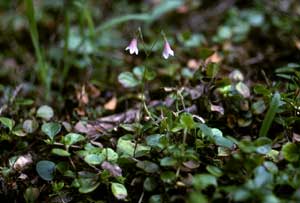
(Western Twinflower)
[L.]
Subclass: Asteridae
Order: Dipsacales
Family: Caprifoliaceae
Family Description: Honeysuckle
Key Characteristics:
| Mat forming, creeping, semi-woody , evergreen shrub; vertical naked peduncles 3-10 cm tall terminating in two divergent, pink flowers; no stipules | |||
|
stems
|
leaves
|
flowers
|
fruit
|
|
|
|
|
General Description:
This creeping forest floor plant was a favorite of the famous biologist Carolus Linnaeus and is named in his honor. It has evergreen, oppositely arranged leaves. Each leaf has a few shallow teeth on the upper half only. The stems grow across the soil surface with occasional upright flower stalks. The pendant, pink, funnelform flowers grow in pairs on the tip of 4 inch high flower stalks. These plants usually grow in moist coniferous forests in the mountains.
Distribution:
Circumboreal, Greenland to Alaska, south to West Virginia, Minnesota, New Mexico and California.
Habitat:
Found in wooded areas which are moist & shady.
Other:
Named after Carl Linnaeus, 1707-1778 who stated that it was his favorite flower.
Important State References:
No information available at this time
Photos and Information written by Dr. Karl E. Holte,© 2002
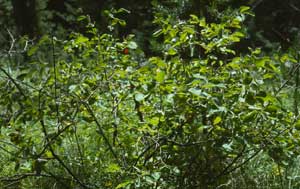
(Utah Honeysuckle)
[Wats.]
Subclass: Asteridae
Order: Dipsacales
Family: Caprifoliaceae
Family Description: Honeysuckle
Key Characteristics:
| shrub, 1-2 m tall; deciduous, opposite leaves; flowers pale yellow, in axillary pairs | ||
|
leaves
|
flowers
|
fruit
|
|
|
|
General Description:
This shrub is commonly about 1 meter tall, but can grow to two meters. Its opposite pale leaves are glaucous on the lower surface. The ochroleucous or light yellow, 10-20 mm long, funnelform flowers grow in pairs and result in bright red fruits which are slightly united at their bases. The flowers are only slightly or not at all bilabiate. None of the books on edible and poisonous plants mention this species. However, the commonly cultivated species, Lonicera tatarica is described as follows:
Lonicera poisoning is considered extremely serious. Recovery in non-fatal cases is prolonged, generally 3 days or more. Shortly after ingestion there is severe and persistent emesis, colic and diarrhea. There is a sensation of blood rushing to the head. The face, particularly the eyelids, becomes reddened. There is mydriasis and photophobia. Shock-like symptoms develop, including cold sweat, and tachycardia. Whether the cardiac rhythm disturbances are related to hypotension or are intrinsic reaction to the toxins has not been investigated. There is a twitching of the limbs which may be followed by convulsions. Terminally there is respiratory depression and death in coma. The nature of the toxins in the berry of the honey suckles is unknown. Intoxications differ from the other members of this group in that non-shock related systemic reactions can be observed.
Distribution:
Southern British Columbia to northern California, east to Alberta, Montana, Wyoming, and Utah, but east of the Oregon Coast ranges.
Habitat:
Moist, woodlands or open slopes at moderate to rather high elevations.
Other:
The bright red fruits are enticing to children who often get sick from eating them.
The members of the genus have different properties. Some have emiticocathartic properties. The seeds of some are diuretic. The herbage of the true honeysuckle was a favorite food of goats, thus the old name Caprifolium which means goat leaf (Capri = goat, folium = leaf). The berries of some species was used as a food for chickens and birds are reported to eat them during difficult times, but they are said to be purgative and emetic. The name Lonicera was given by Linnaeus in honor of Adam Lonicer, a physician and naturalist, born at Marburg in 1528, who wrote, among opther works, the Naturalis Historiae Opus novum, which contains much curious information about plants (1992 Grieve, Mrs. M A modern Herbal.) In some species, a syrup was made from the flowers and used as an expectorant and laxative. Also some were said to have properties for treating respiratory and spleen problems
Important State References:
No information available at this time
Photos and Information written by Dr. Karl E. Holte,© 2002
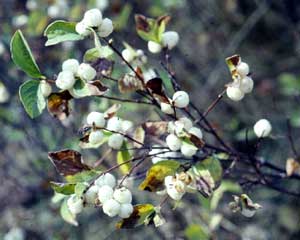
(Mountain Snowberry)
[Gray]
Subclass: Asteridae
Order: Dipsacales
Family: Caprifoliaceae
Family Description: Honeysuckle
Key Characteristics:
|
Erect, branching shrub to 1.5 m tall with opposite, deciduous leaves; white berries; twigs and leaves may be pubescent or glabrous |
||
|
leaves
|
flowers
|
fruit
|
|
|
|
General Description:
This erect, branched shrub can grow up to 1.5 m tall. The elliptic, opposite leaves are usually 1-2 cm long, but in young growth can exceed 2 or 3 times that length. The elongate-campanulate flowers are borne on short, drooping pedicels from the axils of the upper leaves. The inferior ovaries in the flowering stage are frequently purple. The 7-10 mm long fruits, however, are white. Following the common sense rule, "If the plant grows in the wild and has white fruits, don't eat it because it is either deadly or will make one very sick." Birds, which have different digestive enzuy.
Distribution:
East of the Cascades, from southern British Columbia to Montana, south to California, New Mexico and northern Mexico.
Habitat:
With sage brush in open slopes and in dry meadows from low to mid-elevation to moderate elevations in the mountains.
Other:
Plants which have white fruits on plants which grow in the wild should be regarded as inedible, in fact toxic to Homo sapiens. Snowberries may cause emesis and drastic catharsis. It can cause delirium and a semi-comatose condition. A period of time of 1 or 2 hours may elapse between eating and gastroenteritis or even as much as one or two days for toxalbumins which are slowly absorbed from the gastorenteric tract.
Important State References:
No information available at this time
Photos and Information written by Dr. Karl E. Holte,© 2002.
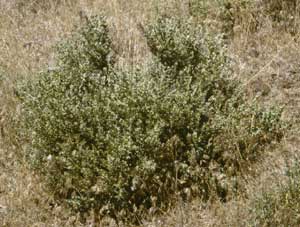
(Shadscale)
[Wats.(Torr. & Frem.)]
Subclass: Caryophyllidae
Order: Caryophyllales
Family: Chenopodiaceae
Family Description: Goosefoot
Key Characteristics:
| Also known as Saltbush. | ||
|
leaves
|
flowers
|
fruit
|
|
|
|
General Description:
An erect, rounded, woody, dioecious shrub which forms sharp spines by the leaves. It is orbicular-ovate to obovate, entire, permanently grayish or white, scurfy leaves 1-2 cm long with short petioles. The fruiting bracts are orbicular to broadly elliptic. It grows in dry, saline soil.
Distribution:
Oregon to California, east to south central Idaho and southern Montana, Colorado and northern Mexico.
Habitat:
Dry areas with saline soil.
Other:
A rather important browsing plant in desert areas.
Important State References:
No information available at this time
Photos and Information written by Dr. Karl E. Holte,© 2002
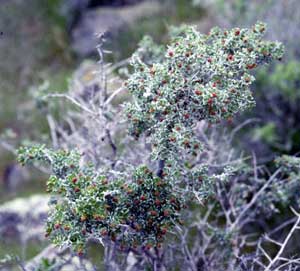
(Spiny Hopsage)
[(Hook.) Collotzi]
Subclass: Caryophyllidae
Order: Caryophyllales
Family: Chenopodiaceae
Family Description: Goosefoot
Key Characteristics:
|
leaves
|
flowers
|
fruit
|
|
|
|
General Description:
Erect, grayish-barked shrub, 3-12 dm tall, much branched, often twigs are spiny; herbaceous parts scurfy; evergreen leaves spatulate to oblanceolate; fruiting bracts most often reddish, varying to greenish-white
Distribution:
East of the Cascades - Eastern Washington southward to southern California and Arizona eastward to southwest Montana, Western Colorado and Wyoming.
Habitat:
Grows in alkaline soil areas.
Other:
Some members of this genus are used as flavoring, ashes for a substitute for baking powder, to color cornmeal, achenes can be ground into meal; evergreen leaves make it a valued landscaping plant.
Important State References:
No information available at this time
Photos and Information written by Dr. Karl E. Holte,© 2002
(Common Juniper)
[L.]
Class: Pinopsida
Order: Pinatae
Family: Cupressaceae
Family Description: Cypress
Key Characteristics:
| Also known as Dwarf/Prostrate Juniper. Prostrate or low, dioecious shrub, usually less than 2 m tall, forming dense mats up to 1-3 m in diameter; leaves in threes, linear-lanceolate, awl-shaped, sharp pointed, 6-12 mm long, abaxially dark green, deeply grooved and white on adaxial side, jointed at base. | ||
|
leaves
|
cones
|
seeds
|
|
|
|
General Description:
Common Juniper is a prostrate, trailing, up to 3 meter tall, dioecious shrub usually associated with and found growing under Subalpine Fir or other conifers. At higher elevations it may be found growing in the open. The somewhat reddish bark is thin, shredding, and somewhat scaly. The leaves are mostly in three ranks. They are distinctive from the other junipers because they are jointed and remind one of a canoe because they are pointed, concave, and whitish on the inner surface (adaxial) but dark green on the abaxial surface. They can be up to 12 mm long. The dark blue, ovulate cones require two years to mature. They reveal that they are really cones in that the lines of the 3 to 8 fleshy scales are prominent and each usually has a point remaining. They are up to 12 mm in diameter and very fleshy.
Similar Species:
Juvenile Rocky Mountain Juniper
Distribution:
To Alaska south in the mts. to California, east to Newfoundland and Greenland, North Carolina, Georgia, Texas.
Habitat:
From sea level to alpine areas; at lower elevations under other conifers in open woods, mountain valleys; at higher elevations on open, slopes.
Other:
Many varieties used as cultivars; ripe seed cones and leaves as a tincture; seed cones can be chewed before a meal for achlorhydria; eaten as a snack or survival food, said to lower blood sugar from adrenalin hyperglycemia; to alleviate symptoms of urinary tract infections and urethritis; seed cones also used for a volatile oil in the production of gin for its flavor and diuretic properties; oil of juniper is also used as a diuretic, stomachic, and carminative in indigestion, flatulence, and diseases of the kidneuy and bladder and can be mixed with lard or other fat to be put on animal sores to discourage flies.
Important State References:
No information available at this time
Photos & information written by Dr. Karl E. Holte,© 2002
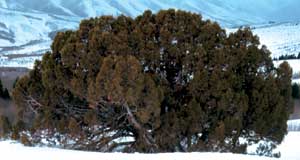
(Utah Juniper)
[Torrey/Little]
Class: Pinopsida
Order: Pinatae
Family: Cupressaceae
Family Description: Cypress
Key Characteristics:
| A rough, bushy tree up to 6 m tall, often branched at the base and up to 8 dm thick with grayish-brown bark; leaves in twos or occasionally in threes, acute or acuminate, glandless or inconspicuously glandular on the back, yellowish-green; berries (seed cones) maturing the second year, rounded or oblong with 1 or rarely 2 seeds. | ||
|
leaves
|
cones
|
seeds
|
|
|
|
General Description:
Its habit is a round-crowned shrub usually with many trunks which originate from the base and bear thin, grayish-brown, exfoliating bark. It is commonly six to twelve meters tall. Its branches are spreading to ascending. The branchlets are three- to four-sided and about as thick as the triangular-shaped, scale-like leaves are long. The light yellow-green scale-like, acute or acuminate, gland less or inconspicuously glandular adult, tiny leaves are usually arranged in twos, but sometimes in threes. They are appressed, one to two millimeters long and tend not to overlap each other. Saplings have three to four times longer, acuminate, stiff, sharp-pointed awl-like leaves. The ovulate cones contain one or two seeds and mature in one or two years in two different sizes. The bluish, glaucous cones (often called berries) appear copper-colored if the wax covering is rubbed off.
Similar Species:
Rocky Mountain Juniper
Distribution:
Great Basin and Rocky Mountain area from Wyoming, across S. Idaho to Nevada, South to N. M. and California.
Habitat:
Dry plains and foothills.
Other:
A valuable shrub or tree for fence posts that resists decay for decades. They are not used for lumber because they crack upon drying and tend to be very knotty. Seed cones can provide a survival snack and are readily eaten by many birds and rodents.
Important State References:
No information available at this time
Photos & information written by Dr. Karl E. Holte,© 2002
(Rocky Mountain Juniper)
[Sarg.]
Class: Pinopsida
Order: Pinatae
Family: Cupressaceae
Family Description: Cypress
Key Characteristics:
| A slender, graceful, single-stemmed tree up to 15 m tall and the trunk up to l m thick or 2 or more trunks from a single crown with reddish-brown bark; leaves acute or acuminate, 1-1.5 mm long, oppressed, dark green with obscure glands on the back; berries globose, maturing the second season, 1-2 seeded. A valuable tree for ornamental plantings. Moist soil of streams and hills. Alta. To B.C. south to Tex., Ariz., and Nev. | ||
|
leaves
|
cones
|
seeds
|
|
|
|
General Description:
The Rocky Mountain Juniper or sometimes called River Juniper is usually a columnar, dioecious up to 10 meter tall tree with one main trunk. Occasionally it is somewhat rounded or higher elevations somewhat shrub-like. The bark is usually somewhat reddish in color and as the tree ages it becomes somewhat stringy or fibrous. One way of distinguishing it from the Utah juniper is that the twigs or branchlets are thinner and the leaves are mostly opposite. The leaves on mature trees are scale-like with entire margins. The leaves on juvenile specimens are awl-like and can range from 5-7 millimeters in length. These may remain on those branches until the tree is mature. The berry-like seed cones are smaller than those of the Utah Juniper and are up to 6 millimeters in diameter. When the wax is rubbed off, they become a darker blue rather than copper colored.
Juvenile specimens are similar to the Common Juniper (Juniperus communis) but does not have jointed leaves with concave upper surface that the common juniper has.
The seed germination is enhanced by removing the fleshy cone. This is often accomplished by going through the digestive tract of birds or mammals. Bighorn sheep, and birds such as Townsend's solitaire feed on this plant. It may live up to become up to 1500 years old.
Similar Species:
Utah Juniper, Common Juniper
Distribution:
Southern Vancouver Island, British Columbia, east central Washington , Eastern Oregon, to Montana, Dakotas, Nefvada, Northern Arizona, New Mexico, Colorado and Western Nebraska.
Habitat:
Coastal islands to dry plains and valleys and lower mountains, usually near streams or wetter soils.
Other:
Sometimes used as fence posts and rails because of their straight trunks. Native Americans regarded it as sacred and regarded the smoke from it to be effective in relief from colds, to prevent sickness in general, evil spirits, heal horses and believed that lightening never struck these trees. Native Americans also burned it to purify their homes, for good luck prior to hunting, to stimulate urination, sweating, curing venereal diseases, heart, lung, and kidney problems, and to help digestion and increase appetite.
Although teas can be made from the berries and leaves, caution should be exercised. People with kidney problems or pregnant women should avoid ingestion. Junipers were used in Europe to induce abortion and were termed "Bastard Killer."
Important State References:
No information available at this time
Photos & information written by Dr. Karl E. Holte,© 2002
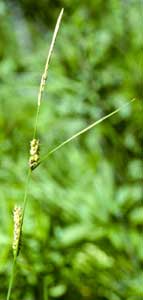
(Sedges)
Subclass: Commelinidae
Order: Cyperales
Family: Cyperaceae
Family Description: Sedge
Key Characteristics:
| Grass-like, triangular stems, fused leaf sheaths. | ||
|
leaves
|
flowers
|
fruit
|
|
|
|
General Description:
Carex plants are known to be difficult to identify and many studies just refer to them as sedges or “Carex spp.” They are grass-like plants, but unlike most grasses, sedges have triangular stems, fused leaf sheaths, and solid, pith-filled stems. Plants may be rhizomatous or clustered. The plants usually are monoecious with one or more staminate spike inflorescence and one or more pistillate spike inflorescence or the inflorescences may be composed of both staminate and pistillate flowers; if the male infloresence is terminal or the male flowers in any spike are terminal, the term covering this is that the plant is “androgynous.” If the pistillate inflorescence is terminal or the pistillate flowers are terminal in a spike with the staminate flowers at the bottom of the spike, the condition is referred to as “gynaecandrous.” Very seldom are plants dioecious. Spikes are subtended by a bract which can be large and leaf-like to small and inconspicuous or absent; spikes can be sessile or pedunculate and compactly or loosely arranged. flowers have no sepals and no petals; each flower is subtended by a small, scarious bract referred to as a “scale.” Staminate flowers have 3 stamens. The pistil in pistillate flowers is surrounded by a sac-like bract called a perigynium. The two or three style branches are exerted through an opening in the perigynium referred to as the mouth. Each perigynium is subtended by an unfused bract referred to as a pistillate scale. If there are two stigmas or style branches, the achene is lenticular (two sided); if there are three stigmas or style branches, the achene is trigonous (three sided).
Distribution:
Circumboreal.
Habitat:
Most sedges are found in moist areas by streams, open water or meadows. Some however, are found in woodlands or even in desert areas.
Other:
The genus, Carex , is extremely important in erosion control because of its extensive fibrous root system with or without rhizomes. They are important for grazing and in wild hay harvest for domestic livestock. While sedge achenes are edible, they are not normally utilized by Homo sapiens.
Important State References:
No information available at this time
Photos and Information written by Dr. Karl E. Holte,© 2002
(Mountain Labrador-tea)
[Nutt.]
Subclass: Dilleniidae
Order: Ericales
Family: Ericaceae
Family Description: Heath
Key Characteristics:
| Also known as Smooth Labrador-tea or Trapper’s Tea. | ||
|
leaves
|
flowers
|
fruit
|
|
|
|
General Description:
Plant an evergreen shrub 0.5-2 meters tall with puberulent, glandular-dotted twigs; revolute, entire- margined, alternately arranged, leaves which are dark green on adaxial surface and light green to grayish on abaxial surface: glandular and puberulent on abaxial surface.
Distribution:
Alberta to Alaska south to Colorado and California, from British Columbia to Montana, central Idaho and northwest Wyoming.
Habitat:
Grows in high mountain bogs.
Other:
Tea was made from leaves of the entire genus from the American War of Independence to present. They make the best tea if collected prior to flowering. They contain tannin, gallic acid, wax, resin and salts. They are said to be a tonic, diaphoretic, and pectoral having a pleasant odor and spicy taste. As a wash, they are said to kill lice. It is also said that the leaves will keep away moths if scattered among stored clothing.
Important State References:
No information available at this time
Photos and Information written by Dr. Karl E. Holte,© 2002
(Rusty Menziesia)
[Nutt.]
Subclass: Dilleniidae
Order: Ericales
Family: Ericaceae
Family Description: Heath
Key Characteristics:
| Also known as Smith Fool’s Huckleberry, Mock Azalea, Rusty-leaf or Rusty Menziesia. | ||
|
leaves
|
flowers
|
fruit
|
|
|
|
General Description:
Deciduous, erect, slender shrubs, 2-3 meters tall with alternate, obovate, thin, oblong to obovate-elliptic leaves; fruit a capsule.
Distribution:
Alberta and British Columbia east to Wyoming, west to eastern Washington and Oregon, along Columbia River to Mount Hood and Mount Adams.
Habitat:
Found in moist woodlands and streambanks of mountains.
Other:
No human uses found.
Important State References:
No information available at this time
Photos and Information written by Dr. Karl E. Holte,© 2002
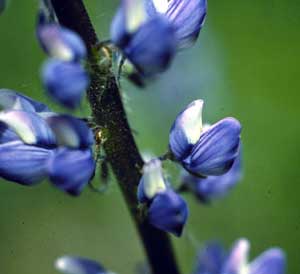
(Lupine)
Subclass: Rosidae
Order: Fabales
Family: Fabaceae [Leguminosae]
Family Description: Pea
Key Characteristics:
| Also known as Bluebonnet | ||
|
leaves
|
flowers
|
fruit
|
|
|
|
General Description:
33 species or varieties are listed for Idaho. Annual, biennial or perennial herbs (sometimes shrubs in other areas); leaves alternate, palmately compound with 3-17 leaflets; papilionaceous, blue, white, pink, yellow, or violet colored flowers in terminal racemes; calyx 2-lipped sometimes saccate or spurred; banner broad, with reflexed margins and a median groove; wings curved, often fused terminally, often enclosing the keel; keel sickle or boat-shaped; 10 stamens fused by their filaments ( monadelphous), the anthers alternately larger and smaller; fruit a flat, hairy legume opening along two sutures.
Distribution:
Common throughout North America, but found on all continents except Australia
Habitat:
Dry sage brush habitat to moist woodlands at most elevations
Other:
Economically important because many species are cultivated as ornamentals while some are used as sand binders along coastlines; many provide high protein food for animals; in some areas cultivated as nutritious fodder. Native Americans ate some with extensive preparations which rendered them less toxic.
The principle ingredient is a bitter glycoside lupinin, which when boiled with dilute acids is decomposed into lupigenin and a fermentable glucose. A carbohydrate similar to dextrin has been found in some species; bruised seeds of some species soaked in water has been used as external application to sores and internally as an anthelmintic, diuretic and emmenagogue.
Even though they are a member of a family which has many edible and nutritious members, they should be regarded as poisonous to both livestock and Homo sapiens. However, the native Americans steamed the leaves or roasted the roots. A tea was made from the seeds and used as a curative. They yield gold or yellow hues if a mordant such as alum, chrome, copper, tin is used, or tan if iron is used
Important State References:
No information available at this time
Photos and Information written by Dr. Karl E. Holte,© 2002
Genus & Species Common Name Family Family Common Name
Trifolium repens L. White Clover, Dutch Clover Fabaceae Pea Family
CHARACTERISTICS
A glabrous, more or less prostrate plant with erect, naked peduncles
terminated by a head-like raceme of white to pink flowers. The 1-6 dm
long stems are usually creeping and stoloniferous, but sometimes erect.
leaves
The trifoliate leaves are subtended by 3-10 mm long stipules which are
fused nearly their entire length; each has a white spot or band; The
petioles vary in length from about equal in length to the leaflets to
many times longer; the leaflets are obovate, 1-2 cm long, finely
serrulate.
flowers
There is no involucre; The white, cream or pinkish flowers are borne
in heads borne on axillary, long peduncles; The flowers become pendulous
on 1-5 mm long pedicels at maturity; the glabrous calyx with teeth about
the length of the tube is about ½ the length of the corolla.
fruit
a 1-3 seeded legume
habitat
White Clover has been introduced into North America from Europe and has
become established in meadows, waste places, lawns and moist places
where it appears to be native. It is often associated with Kentucky
Bluegrass.
distribution
In North America from the Aleutian Islands southward through the entire
lower continental United States.
other
Although low growing, this plant provides good, nutritious grazing for
domestic stock and wildlife. It is often included in lawn grass seed
because of its nitrogen fixing ability. Clover honey is made primarily
from the nectar of this plant. The nutritious leaves can be added in
small quantities to salads or as a green on sandwiches.
Photos and content written by Karl Holte, 2002
Philadelphus lewisii Pursh Mockorange, Syringa Hydrangeaceae Hydrangea
Family
Idaho State Plant.
CHARACTERISTICS
Shrub 1.5- 3 meters tall
leaves
2.5-7 cm long, commonly 1-4 cm wide, mostly ovate, ovate-lanceolate,
margins entire or remotely denticulate on older branches, but differing
on sprouts being serrate, dentate; hairiness varies from glabrous to
hairy on both surfaces;
flowers
Fragrant, thus the name Mockorange; lower flowers from leaf axils in a
gradient from leafy to bractless at the terminus in racemes; adnate
portion of the calyx usually glabrous, the ovate, ovate-lanceolate four
calyx lobes approximately equal in length to the 6 mm long
turbinate-shaped portion; four oblong, oblong-ovate petals white, obtuse
or emarginate; numerous stamens vary from 25 to 50 per flower, filaments
and anthers with 1-numerous hairs; styles equal in length to the
stamens, connate from ½ length to entire length; ovary appearing to be
inferior
fruit
an ovoid 6-10 mm long capsule appearing to be inferior, but actually
only so about 3/5 of the way with pointed ends; linear seeds bear an
erose-coronate caruncle on one end.
habitat
along streams, in rocky basalt areas, talus slopes in dry areas with
sagebrush and Ponderosa Pine.
distribution
British Columbia to northern California eastward through southern
British Columbia, Washington, Oregon to Continental Divide in Montana
and in Idaho north of the Snake River, varying in elevation from sea
level to about 7000 ft.
other
This is the Idaho State Flower. It is a valuable ornamental. The
large, white flowers cover the erect shrub.
Photos and content written by Karl Holte, 2002
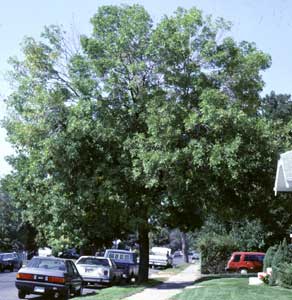
(Green Ash)
[Marsh.]
Subclass: Asteridae
Order: Scrophulriales
Family: Oleaceae
Family Description: Olive
Key Characteristics:
| Non-native species | ||
|
leaves
|
flowers
|
fruit
|
|
|
|
General Description:
Green ash is not native to Idaho, but is commonly cultivated and sometimes escapes and appears to be native. It is the most widely distributed of all the native ash species. It is native east of a diagonal line extending from Alberta Canada through central Montana to eastern Texas. It is common along stream banks, flood plains, and wet upland sites. It is a fast growing tree which produces vast crops of samaras in late summer and autumn. These fruits are an important food source for wood ducks, quail, turkey, cardinals, finches, and other rodents such as squirrels. Deer and moose browse on the young twigs.
Distribution:
It is native east of a diagonal line extending from Alberta Canada through central Montana to eastern Texas.
Habitat:
Stream banks, flood plains, and wet upland sites.
Other:
Fruits are an important food source for wood ducks, quail, turkey, cardinals, finches, and other rodents such as squirrels. Deer and moose browse on the young twigs. The wood is light-brown, hard, heavy, and moderately strong. It is used for tool handles, oars, paddles, baseball bats, snowshoes, tennis rackets and frames and has been used some for furniture such as decorative shelving. It has been widely used as an ornamental tree and has proved to be resistant to diseases which kill other cultivated ashes.
References:
Davis, Ray J. 1952, Fora of Idaho. Wm . C. Brown Company Dubuque, Iowa
Elias, Thomas S., 1987. The complete Trees of North America, Gramercy Publishing Company. New York
Hitchcock, C. Leo & Arthur Cronquist , 1973, Flora of the Pacific Northwest. Univ. of Washington Press. Seattle and London
Hitchcock, C. Leo & Arthur Cronquist , 1961, Vascular Plants of the Pacific Northwest. Univ. of Washington Press. Seattle, Washington
Moore, Michael, 1993, Medicinal Plants of the Pacific West. Red Crane Books 826 Camino de Monte Rey Santa Fe New Mexico 87501
Photos and Information written by Dr. Karl E. Holte,© 2002
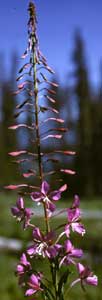
(Fireweed)
[L.]
Subclass: Rosidae
Order: Myrtales
Family: Onagraceae
Family Description: Evening Primrose
Key Characteristics:
| Also known as Blooming Sally. | ||
|
leaves
|
flowers
|
fruit
|
|
|
|
General Description:
Stems mostly unbranched, glabrous except in the inflorescence, arising from rhizome-like roots that freely form adventitious buds; up to 25 dm tall with alternate, lanceolate to linear-lanceolate, sub-entire, sessile leaves.
Flowers in long, terminal racemes, each flower subtended by small, linear bracts
Distribution:
Alaska to California east to the Atlantic Coast
Habitat:
Moist places, often in disturbed sites such as after a fire, after logging, along old highways, and railroads
Other:
This makes a beautiful flower bed plant, but it is advisable to plant it in an area which is confined by sidewalks, edging, etc. because it will spread by its rhizomes.
It makes a safe tea. The tea can be used for chronic, pasty diarrhea, to improve colon tone, a mild laxative, douches, enemas, and infant washes where there is inflamation of the orifices and tender folds. It can work as an anti-inflammatory for throat, stomach, intestinal inflammation, hemorrhoid inflammation that flares up after eating spicy or other irritating foods.
Other References:
Davis, Ray J. 1952, Fora of Idaho. Wm . C. Brown Company Dubuque, Iowa
Hitchcock, C. Leo & Arthur Cronquist , 1973, Flora of the Pacific Northwest. Univ. of Washington Press. Seattle and London
Hitchcock, C. Leo & Arthur Cronquist , 1961, Vascular Plants of the Pacific Northwest. Univ. of Washington Press. Seattle, Washington
Moore, Michael, 1993, Medicinal Plants of the Pacific West. Red Crane Books 826 Camino de Monte Rey Santa, Fe New Mexico 87501
Photos and Information written by Dr. Karl E. Holte,© 2002
(White Fir)
[Lindl. (Gord. & Glend.)]
Class: Pinopsida
Order: Pinatae
Family: Pinaceae
Family Description: Pine
Key Characteristics:
| Also known as White Balsam or Silver Fir. | ||
|
leaves
|
cones
|
seeds
|
|
|
|
General Description:
Also known as White Balsam or Silver Fir. A tree up to 75 m tall with a spire-like crown. The branches are glabrous and shining (may be moderately pubescent & pale greenish to yellow-brown). Leaves are nearly flat with a pale bluish-green color. They are blunt with more or less erect on the branches. Dimensions are 5-7 cm long, about 3 mm wide. The staminate cones are red. The mature ovulate cones are 7-12 cm long, the scales 3-3.5 cm wide, fan-shaped. The bracts are scarcely half as long as the scales. Seeds are found to be 8-12 mm long with a wing about twice as long.
Distribution:
Moderate altitudes of the mountains Colo. across Idaho to North. Oregon., south to New Mexico and California.
Habitat:
Found in low elevations in the mountains.
Other:
Needles can be made into a tea which is diuretic or can be used as an expectorant or burned as an incense.
The bark can be used externally as an astringent externally with some disinfectant properties or internally for intestinal tract, lung, or skin/mucosa problems.
The pitch, bark, and needles can be made into a tea which can be used as a wash, or drunk several times a day.
Important State References:
No information available at this time
Photos & information written by Dr. Karl E. Holte,© 2002
Genus & Species Common Name Family Family Common Name
Abies. grandis (Dougl.) Forbes Grand Fir, or Lowland, Pinaceae Pine
Family
Lowland White, silver,
or Balsam Fir
_________________
CHARACTERISTICS
A tree up to 90 m tall, with long drooping branches which are puberulent
on the young growth; leaves 3.5-5 Cm long, about3 m wide, forming flat
sprays, deeply grooved below; staminate cones yellowish; mature ovulate
cones 12-18 cm long, greenish; scales broadly fan-shaped, 3 cm broad,
2.5 cm long; bracts scarcely half as long, irregularly toothed and
short-pointed; seeds about 8 mm long, their wings about twice as long.
W. Mont. to B. C., across N. Idaho and south to Calif.
leaves
leaves 3.5-5 cm long, about 3 m wide, blunt to notched, forming flat
sprays, deeply grooved below with two stripes of stomata but with no
stomata stripes on the flat, shallowly channeled upper surface;
small resin ducts are located less that 1/4th of the leaf width in from
the margin just above the lower epidermis;
Cones
staminate cones yellowish; mature ovulate cones are erect and their
scales fall off when seeds are shed; 5-10 cm long, up to 4 cm wide,
greenish; scales broadly fan-shaped, 3 cm broad, 2.5 cm long; bracts
scarcely half as long, irregularly toothed and short-pointed;
seeds
brownish, 8-9 mm long, shorter than the wing
habitat
from sea level to about 7000 ft elevation in the Rocky Mountains
distribution
Vancouver Island to British Columbia south to California, east to
western Idaho and western Montana to eastern Oregon.
other
Grand Fir hybridizes with White Fir in eastern Washington and Oregon.
needles can be made into a tea which is diuretic or can be used as an
expectorant or burned as an incense..
The bark can be used externally as an astringent externally with some
disinfectant properties or internally for intestinal tract, lung, or
skin/mucosa problems.
The pitch, bark, and needles can be made into a tea which can be used
as a wash, or drunk several times a day.
Rodents, birds and game eat the oil rich seeds. Grouse and deer eat
the needles during the winter months.
The wood is soft because of the trees rapid growth and is not widely
used for lumber, but can be made into pulp.
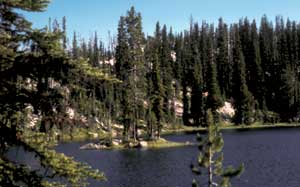
Abies lasiocarpa (Hook.) Nutt. Subalpine, Alpine, Balsam,
Pinaceae Pine Family
or White Balsam Fir.
CHARACTERISTICS
A tree up to 50 m tall with short, dense, rigid upper branches and
drooping longer lower branches, the tree thus easily recognized from a
distance because of its church spire-like appearance, the bark gray,
early smooth except for large resin blisters, the young twigs
rusty-puberulent; At higher elevations, subalpine fir has a shrub-like
appearance; leaves grooved above and ribbed beneath, the lower often
twisted so they all stand erect or nearly so; staminate cones bluish;
mature ovulate cones dark purplish, 6-10 cm long, the scales about 2.5
cm long and broad, the bracts less than half this long and lacerate;
seeds about 6 mm long, High mts. from Alberta to Alaska, south to New
Mexico and California.
leaves
leaves bluish-green, 2 ½- 3 cm long, almost flat, but slightly grooved
with a white stripe above, and ribbed with 2 white stripes beneath, two
resin ducts as large as the midvein located ½ way between the midvein
and margin and upper and lower surfaces; tips blunt or slightly notched;
the lower needles often twisted so they all stand erect or nearly so
Cones
Staminate cones bluish, about 9 mm long; when shedding their seeds,
mature cones fall apart leaving a center stalk erect on the tree;
mature ovulate cones dark purplish, 6-10 cm long, about 3 cm broad; the
scales about 2.5 cm long and broad, the bracts less than half this long
and lacerate
Seeds
6-7 mm long
habitat
In Idaho usually above 5000 feet in elevation up to timberline.
distribution
South Alaska and Yukon to Alberta, south in higher mountains in Idaho,
Montana, Wyoming south through Colorado to New Mexico and Arizona.
other
Grand Fir hybridizes with White Fir in eastern Washington and Oregon.
needles can be made into a tea which is diuretic or can be used as an
expectorant or burned as an incense..
The bark can be used externally as an astringent externally with some
disinfectant properties or internally for intestinal tract, lung, or
skin/mucosa problems.
The pitch, bark, and needles can be made into a tea which can be used
as a wash, or drunk several times a day.
Because of the pitch pockets, it pops and sputters while burning, thus
many do not even like to use it as firewood. From a lumbering
standpoint, it is not utilized except for pulp, boxes and crates.
Photos and content written by Karl Holte, 2002
(Tamarack)
[Parl.]
Class: Pinopsida
Order: Pinatae
Family: Pinaceae
Family Description: Pine
Key Characteristics:
| Also known as Lyall Larch or Alpine Tamarak. | ||
|
leaves
|
cones
|
seeds
|
|
|
|
General Description:
A small deciduous tree often dwarfed, unsymmetrical, usually 15-20 m tall occasionally taller and 5-6 (-10) dm in diameter; bark of the trunk slightly furrowed, reddish-brown; young branches white-villous for about 2 seasons; leaves 3-4 cm long; cones ellipsoid, 3-5 cm long, tomentose; scales obovate, erose; bracts much longer, 3 -lobed; seeds about 3 mm long. High mts. near timber line. Alberta to B. C across N. Idaho to Washington. and Oregon.
Distribution:
Cascade Mountains of southern British Columbia to the Wenatchee Mountains Washington east to Alberta northern Idaho and Western Montana.
Habitat:
Subalpine to alpine areas where the snow is last to leave.
Other:
Because of where it is found and its misshapen habit, this species is of little or no economic value except for camping firewood. They are not known to be of much value to wildlife.
Important State References:
No information available at this time
Photos & information written by Dr. Karl E. Holte,© 2002
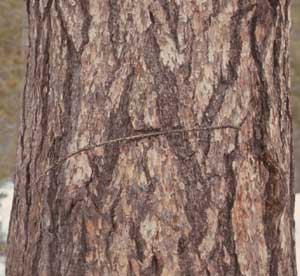
(Western Larch)
[Nutt.]
Class: Pinopsida
Order: Pinatae
Family: Pinaceae
Family Description: Pine
Key Characteristics:
| Also known as Hackmatack. | ||
|
leaves
|
cones
|
seeds
|
|
|
|
General Description:
A deciduous tree up to 75 m tall ad 1-2 m in diameter with a short pyramidal crown, with thick, deeply-furrowed, brown bark; young twigs never tomentose; leaves 2.5-5 cm long, Short-stalked, ridged on the inner faces; cones 3-4 cm long, oblong, with scales nearly orbicular and bracts much longer than the scales; seeds 6 mm long. Moist mt. slopes, W. Mont, to B. C., actors N. Idaho to Oregon.
Distribution:
Southern British Columbia southward east of the Cascade mountains in northeastern Oregon and adjacent Washington east to Northwestern Montana and northern Idaho.
Habitat:
Mixed with other gymnosperms in mountain valleys and lower slopes, often in swampy areas.
Other:
Seeds are consumed by mice, chipmunks, and birds such as the red crossbill. Buds and needles are eaten by grouse. The wood is hard, close grained and very durable. It is used for flooring, pilings, fence posts, railroad ties and interior and exterior finishing. It is exported to Japan as logs and processed into lumber and resold to the U. S. markets under names such as western spruce.
Important State References:
No information available at this time
Photos & information written by Dr. Karl E. Holte,© 2002
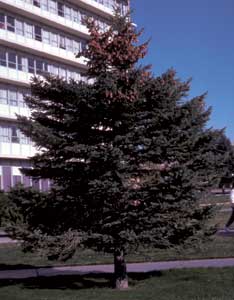
(Engelmann Spruce)
[Parry]
Class: Pinopsida
Order: Pinatae
Family: Pinaceae
Family Description: Pine
Key Characteristics:
| Also known as Columbian, White, Mountain, or Silver Spruce | ||
|
needles
|
cones
|
seeds
|
|
|
|
General Description:
A spire-like, straight tree up to 50 m tall and a trunk up to 1-1.5m in diameter, with spreading branches in regular whorls, forming narrow pyramidal crowns; branchlets pubescent for 3-4 years; leaves 4-angled, ill-scented, 2.5-3 cm long, glaucous when young; cones oblong-cylindric, brown; scales thin, erose-dentate; seeds nearly black about 3 mm long. Hills. B.C. to N. M., Ariz.., and Calif.
Distribution:
Yukon, British Columbia southward through the Cascade Mountains in Washington, Oregon and California eastward to southwestern Alberta, Idaho, Montana, southward in the Rocky Mountains to New Mexico, Utah and Arizona.
Habitat:
Montane on dry slopes or around swamps mostly at elevations exceeding 3000 feet.
Other:
Where their ranges overlap, Engelmann Spruce appears to hybridize with Sitka Spruce, White Spruce and Colorado Blue Spruce.
“Spruces are valuable trees, both to man and wildlife. Since the spruce grouse is almost entirely dependent upon spruce trees for food and cover, its range is the same as that of the various spruces. The blue grouse also utilizes spruce for food and shelter but a a lesser extent than the spruce grouse. Whitetail deer and rabbits browse twigs and leaves of young plants; while squirrels, chipmunks, and seed-eating birds especially the white-winged crossbill, consume large quantities of spruce seeds. The soft, odorless wood is used for many purposes. Spruces are probably the most important source of pulp wood in North America. Several species are planted widely for ornamental purposes and for windbreaks.” (Elias, 1987)
The wood of Engelmann Spruce is not widely used because of its habitat of high mountainous areas. But if used, is grouped with other spruces. The soft, yellowish-brown, resilient wood is used in general construction. It is important for firewood. It was used by native Americans and early settlers for tanning leather.
Important State References:
No information available at this time
Photos & information written by Dr. Karl E. Holte,© 2002
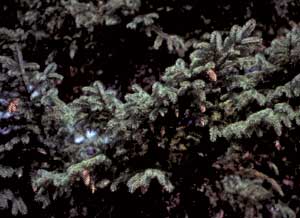
(White Spruce)
[(Moench.) Voss]
Class: Pinopsida
Order: Pinatae
Family: Pinaceae
Family Description: Pine
Key Characteristics:
| Also known as White, Canadian, Black Hills, Cat, or Skunk Spruce. | ||
|
needles
|
cones
|
seeds
|
|
|
|
General Description:
The hardy White Spruce tree barely enters Idaho at the extreme northern “panhandle.” Although its range is from Alaska southward through Minnesota, Wisconsin, Michigan northeastward into the north eastern New England states.
Distribution:
Alaska to Newfoundland southward to British Columbia, northern Idaho and Montana, into northern Wyoming, South Dakota, Wisconsin, Minnesota, Michigan, New York and Maine.
Habitat:
From sea level to 5,600 feet elevation in moist areas along streams and standing water, and on hill and mountain sides. It is found with balsam fir, black spruce, eastern hemlock, quaking aspen, white birch and red maple and not usually in pure stands.
Other:
It is planted as an ornamental in cities and on the ISU campus throughout the west. It is an important food sourse for grouse and other birds, squirrels, the latter eating the cones, buds and young twigs. Porcupines and bears eat the bark sapwood. The wood is light, soft, resilient and straight-grained. It is useful for pulp, boxes, crates and rough general construction lumber. Native Americans once used the roots for basketry and lacework such as for canoes.
Important State References:
No information available at this time
Photos & information written by Dr. Karl E. Holte,© 2002
(Colorado Blue Spruce)
[Engelm.]
Class: Pinopsida
Order: Pinatae
Family: Pinaceae
Family Description: Pine
Key Characteristics:
| usually 25-40 m tall; dense whorls of flattened Sprays, overall appearance is pyramidal and dense. | ||
|
leaves
|
cones
|
seeds
|
|
|
|
General Description:
A tree usually 25-40 m tall, with dense whorls of flattened Sprays and the trunks 5-10 dm in diameter; the overall appearance is pyramidal and dense. The branches are close together, the lower ones drooping slightly and the upper ones point upward slightly. The sharply pointed leaves are strongly incurved, 2-3 cm long, dull bluish-green, often with a silvery bloom. Pistillate cones pale greenish-purple, oblong; seeds 4-6 mm long.
Distribution:
In Idaho, it is found along the Wyoming border. It is found naturally, in patchy distribution in Eastern Idaho, Western Wyoming, Utah, Arizona, Colorado and New Mexico.
Habitat:
This species grows at elevations of 5750 to 11,000 feet in the Rocky Mountains in moister areas along stream and meadows in deep soils. It is commonly found in mixed stands with Engelmann Spruce, Douglas Fir, Lodgepole Pine and sometimes with Ponderosa Pine. However, this species is widely cultivated and is one of the most common conifers in cultivation.
Other:
This species is widely cultivated and is one of the most common conifers in cultivation. Although of limited use for wildlife, its seeds provide some food for squirrels, rodents, and some birds. The light, pale brown wood is lightweight, soft, somewhat brittle and knotty does not have much commercial value.
Important State References:
No information available at this time.
Photos & information written by Dr. Karl E. Holte,© 2002
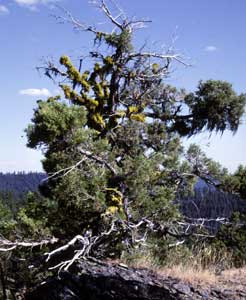
(White Bark Pine)
[Engelm.]
Class: Pinopsida
Order: Pinatae
Family: Pinaceae
Family Description: Pine
Key Characteristics:
| alpine tree 10-15 m tall; crooked or twisted trunk; Cones purplish. | ||
|
leaves
|
cones
|
seeds
|
|
|
|
General Description:
An alpine tree 10-15 m tall, with crooked or twisted trunk and whitish, smooth bark, the twigs yellowish and pubescent; leaves 4-6 cm long, dark green, stiff, slightly curved; Cones purplish, the scales broad at the apex, with a stout, pointed umbo; seeds 10-12 mm long with the narrow wings remaining on the scale. Found only near the timberline. Alta, to B. C., south to Wyo. and Calif. At lower elevations in protected ravines, it is a straight handsome tree, but at higher elevations it has a gnarly shrub-like appearance.
Distribution:
Southern British Columbia southward in the Cascade Mountains to the Sierra Nevada Mountains in California east to south western Alberta southward to west central Montana, northwest Wyoming, throughout Idaho to Northeastern Oregon.
Habitat:
High mountain rocky ridges commonly close to timberline at elevations of 7,700 feet and greater, but can sometimes occur at elevations of 4500 feet in protected canyons. Associates are Engelmann Spruce, Lodgepole Pine and Subalpine Larch.
Other:
The large seeds are eaten by Clark’s Nutcrackers, rodents, and squirrels. Homo sapiens sometimes also roast or eat the seeds raw. The shed needles often supply a comfortable bed for deer and wild sheep. The wood is knotty, lightweight, soft and brittle , thus not useful for lumber, but is sometimes used for firewood, although due to its high elevation habitat is usually not sought after on any large scale.
Important State References:
No information available at this time.
Photos & information written by Dr. Karl E. Holte,© 2002
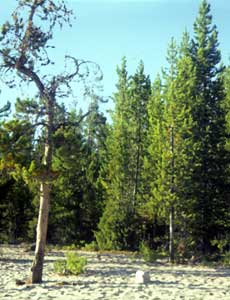
(Lodgepole Pine)
[Dougl.]
Class: Pinopsida
Order: Pinatae
Family: Pinaceae
Family Description: Pine
Key Characteristics:
| Also known as Black, Scrub, Shore, Coast or Tamarack Pine. | ||
|
needles
|
cones
|
seeds
|
|
|
|
General Description:
A slender tree, 20-40 m tall, with a short, rounded, branched crown, and the trunk 4-10 dm in diameter, with thin, scaly bark; leaves bright yellow-green, thick; cones short-ovoid, and often adhering to the tree for years, opened or unopened, but forest fires that kill the tree will usually open the cones and the seeds thus liberated soon start a new stand of trees, Fairly dry situations. Sask. to Alaska, south to Colo. and Calif.
Distribution:
Alaska, Yukon to Baja California east to Alberta, Saskatchewan., Dakotas south through the Rocky Mountains to Colorado.
Habitat:
From sea level up to tree line; in bogs, sand dunes, and around standing water to rocky ridges; can occur in pure stands to mixed stands with Douglas Fir, Idaho White Pine, Red Fir, Subalpine Fir and Ponderosa Pine.
Other:
In Idaho, Lodgepole Pine is a medium-sized tree up to 80 feet tall and can be up to 30 inches in diameter. In good sites (moist, but well-drained sandy or gravelly loam), it has a long, clear, slender, cylindrical bole and short narrow, open crown. At lower elevations its associates are Ponderosa Pine, Douglas Fir and Western Larch. At higher elevations it is found with Engelmann Spruce, Subalpine Fir and Limber pine. It is an aggressive species and can repopulate burned over areas or clear cuts rather quickly because it begins producing seeds as young as 6 years and thereafter a good seed crop every 2-3 years. Some cones remain on the tree unopened with seeds remaining viable for 15-20 years. Maturity is gained after about 200 years although it can live up to 400-600 years. Enemies are bark beetles, fire and Dwarf Mistletoe.
It is an important species for wildlife providing good habitat for grouse, deer and elk. The seeds are staples for pine grosbeaks, Clark’s nutcrackers, squirrels, and rodents such as chipmunks. Porcupines eat the bark. Deer and cattle eat the young saplings.
The wood was once not used except for firewood, but as timber has become more scarce, the light yellow wood which is straight grained, is made into 2x4's for general construction, poles, fencing, railroad ties, mine timbers and for making pulp for paper. The native Americans used the young trees for tepee poles, travois, etc.
Important State References:
No information available at this time
Photos & information written by Dr. Karl E. Holte,© 2002
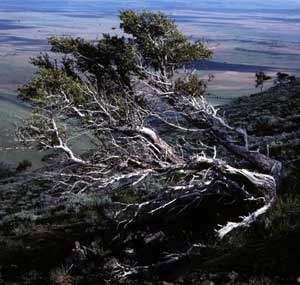
(Limber Pine)
[James]
Class: Pinopsida
Order: Pinatae
Family: Pinaceae
Family Description: Pine
Key Characteristics:
|
needles
|
cones
|
seeds
|
|
|
|
General Description:
Tree 15-20 m tall, with short, stout trunk 1-2 m diameter, with thin whitish bark which later becomes much-cracked; leaves stout, slightly curved, 3.5-7 cm long, Crowded at the ends of the branches; cones light brown, tinged with purple; seeds compressed, 10-12 mm long, the wings usually persistent on the scales after the seeds fall. Mts. of Alta. to B. C., south to Tex. and Calif.
Distribution:
Southeastern British Columbia east to Alberta southward through North and South Dakota through Montana, Idaho to New Mexico west to Nevada, California, north to southeastern Oregon.
Habitat:
Dry, rocky ridges, windy bluffs and mountain tops up to 11,500 feet in elevation
Other:
Limber Pine may grow in pure stands or be associated with Mountain Hemlock, Whitebark Pine, Lodgepole Pine, Douglas fir, White Fir and sometimes with Engelmann Spruce. It can grow on most soil types and is usually slow growing. Its life span is can be up to 300 years, but it is intolerant of fire. Its many branches may droop and touch the ground. In some areas such as the Pahsimeroi Valley its trunk has a twisted appearance. It has a stout taproot and thus can grow on windswept ridges. In appearance, it is difficult to distinguish from White Bark Pine, but the cones are much longer than those of White Bark Pine.
The large seeds are an important food source for birds and rodents and sometimes for Homo sapiens. The wood is light, soft, close-grained and pale yellow. Its use is for boxes, railroad ties, poles and mine timbers. It also is used for firewood.
Important State References:
No information available at this time
Photos & information written by Dr. Karl E. Holte,© 2002
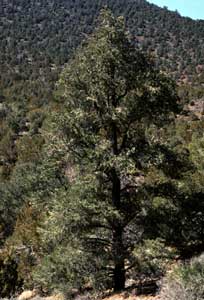
(Singleleaf Pinon Pine)
[Torr.& Frem.]
Class: Pinopsida
Order: Pinatae
Family: Pinaceae
Family Description: Pine
Key Characteristics:
|
needles
|
cones
|
seeds
|
|
|
|
General Description:
A low, sprawling tree with a short, usually crooked trunk and 4-15 m tall; bark irregularly furrowed except on younger limbs where it is smooth and light gray or yellowish; leaves usually 1 but sometimes 2 in a cluster, stout, Curved, 3-5 cm long; cones depressed-ovoid, 3-6 cm long, their scales thick, somewhat 4-sided, knobbed at the apex; seeds 12-15 mm long, edible. Dry hills. s, Idaho to Ariz. and Calif.
Distribution:
The center of distribution is Nevada, found throughout the state except in the extreme northwest. In Idaho it is found only in The City of Rocks area which is its northern most location south through western Utah into eastern California.
Habitat:
The center of distribution is in Nevada in juniper-pine woodlands on lower mountain slopes and canyons from 2100 to 7,800 ft elevation. It lives in dry, rocky soils.
Other:
The seeds, commonly called “pinyon nuts” are eaten by rodents, birds and squirrels. They were a staple food of local Native Americans and early pioneers and are still sought after in August when the cones are shed. Federal agencies, in order to provide for better cattle grazing, removed them by chaining, thus causing a hardship to the Native Americans who were dependent upon the seeds for food and for religious purposes. The oil rich, nutritious seeds are an article of commerce sold in many grocery stores in the produce departments, as well as used as a treat in homes of those who take the effort to collect them. They can be eaten raw, but are better roasted. They are nutritious because they contain much oil and starch. Pine nuts may rank second in use only to the coconut for human consumption.
To separate the seeds from the cones, they can be left to dry in mesh bags or put into ovens on cookie sheets. The heat opens the cones and the seeds fall out.
The heavy, soft wood has some value for fence posts and firewood.
“Pine needles make a very pleasant tea simply for the taste and have a mild diuretic and expectorant function as well. The inner bark boiled slowly for tea and sweetened with honey is still stronger as an expectorant, useful after the feverish, infectious stage of a chest cold has passed. The pitch is the most specific of all; a piece the size of a currant is chewed and swallowed. This is followed shortly afterwards by strong, fruitful expectoration and a general softening of the bronchial mucus. This remedy is especially useful for children. The pitch also has some value as a lower urinary tract disinfectant but would be inappropriate for use when kidney inflammation is present. In New Mexico, trementina (pitch) is warmed slightly over a stove or campfire and applied to splinters, glass, and other skin invaders, allowed to set, and peeled off, carrying the problem with it. While gathering near Questa one day, I encountered an elderly patriarch name Joe Rael (it was mid-afternoon and he was working on his third cord of wood for the winter) who had run a splinter half-way up his arm...or so it seemed. Cursing in obscure Spanish, he grabbed some pitch warmed it over a cigarette lighter in a crushed beer can, and slapped it on the wound, waited a moment, and plucked out the splinter with the pitch. I tried the same thing the next week, and got a blister for my troubles. An acquired technique, I guess. Sometimes it takes several days to facilitate the gradual isolation and extraction of the splinter, so stick with the pitch during several applications.” Quoted from Medicinal Plants of the Desert and Canyon West by Michael Moore, 1941 Museum of New Mexico Press Santa Fe, New Mexico 87504
Pinyon pine nuts contain the following:
refuse 40.6%, water 3.4%, protein 14.6%, fat 61.9%, starch 17.3%, ash 2.8%, and fuel value per pound, 3, 205 calories. (From Smith, J. Russell, 1950. Tree Crops-A permanent Agriculture Inland Press Washington, DC. Also in Harrington, H. D. l
Important State References:
No information available at this time
Photos & information written by Dr. Karl E. Holte,© 2002
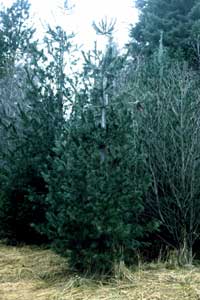
(Idaho White Pine)
[Dougl.]
Class: Pinopsida
Order: Pinatae
Family: Pinaceae
Family Description: Pine
Key Characteristics:
| Also known as Western Pine. | ||
|
needles
|
cones
|
seeds
|
|
|
|
General Description:
A slender tree with a short-branched, narrow symmetrical crown, up to 40 m tall and the trunk 1-1.5 m. diameter; bark checked into small nearly square plates; leaves 5-10 cm long, bluish-green, whitened by 2-6 role of stomata; cones 1-2.5 dm long, light brown; seed about 8 mm long and the wings 25 mm. This is our most valuable lumber tree in Idaho, forming dense, almost pure strands over large areas of the Clearwater River drainage and northward. Middle altitudes of moist situations of the Mts. W. Mont. to B. C., across N. Idaho and south to Calif.
Distribution:
Southern British Columbia to Sierra Nevada in California, western Nevada east to Northern Idaho and southwest Alberta.
Habitat:
Moist valleys to open, dry slopes varying from 0 to 6000 feet in elevation; the largest trees are found on deep, well drained, but wet soils; may occur in pure stands or mixed with Western Hemlock, Western Larch, Douglas Fir, Grand Fir and Western Red Cedar.
Other:
Blister Rust is a disease which adversely affects this species causing cankers on trunks and branches. It is an important lumber tree because of its large size, lightweight, knotless, straight-grained wood. It tends not to warp or shrink. Thus, it is valuable for doors, baseboards, interior finishing, floors, shelving, shutters and window frames and sashes.
It is valuable for wildlife for cover and food. The seeds are eaten buy squirrels, many species of birds such as pine grosbeaks, rosy finches, and nuthatches, and rodents such as white-footed mice. Bears claw the bark and eat the sweet sapwood. Porcupines eat the bark.
Important State References:
No information available at this time
Photos & information written by Dr. Karl E. Holte,© 2002

(Ponderosa Pine)
[Dougl.]
Class: Pinopsida
Order: Pinatae
Family: Pinaceae
Family Description: Pine
Key Characteristics:
| Also known as Western Yellow, Yellow, Pondosa, Blackjack, or Bull Pine. | ||
|
needles
|
cones
|
seeds
|
|
|
|
General Description:
A massive, straight-trunked tree, 30-60 m tall, with a narrow, columnar crown and scattered branches upturned at their ends; trunk 1-2 m in diameter, with thick bark marked by very broad, shield-like red-russet plates; leaves yellowish-green, clustered toward the ends o£ the branches; cones broadly ellipsoid, horizontal or somewhat deflexed, reddish-brown; scales thin, narrow, thickened at the apex, and with prickles; seeds 6-7 mm long, with wings 25-35 mm long. This is a valuable lumber tree. Dry hillsides and plateaus. S.D. to B.C., south to Texas and Calif.
Distribution:
South Centra British Columbia to Baja California east and west of the Cascade Mountains east to S.. E.. British Columbia through the Rockies with a disjunct population in the Black Hills of South Dakota south through Nebraska to western Texas and northern Mexico.
Habitat:
Found at lower to mid-elevations in areas with deep snows and dry summers; at first they grow in “doghair” stands which are thinned by fires; they produce many leaves and cones which cover the understory and cause a fire hazard. Seedlings require open areas, being intolerant of shade. They range in elevation from 0 to 9000 feet. They prefer deep, well drained soils. They grow in pure stands or mixed with Douglas Fir and Western Larch.
Other:
Bark beetles damage or kill these trees. The light, strong wood is used for the manufacture of boxes, crates, toys, furniture, construction, mill products and timbers.
Wildlife such as spruce grouse, pine jays and Clark nutcrackers, chipmunks rely on the seeds. Mule deer , porcupines and rodents feed on young saplings.
Important State References:
No information available at this time
Photos & information written by Dr. Karl E. Holte,© 2002
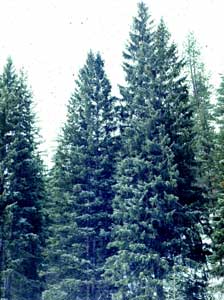
(Douglas Fir)
[(Mirbel) Franco]
Class: Pinopsida
Order: Pinatae
Family: Pinaceae
Family Description: Pine
Key Characteristics:
| Also known as Rocky Mountain Douglas Fir. [Pseudotsuga. taxifolia (Poir.)Britt. ] | ||
|
needles
|
cones
|
seeds
|
|
|
|
General Description:
A tree 50-70 m tall or sometimes taller, with a pyramidal crown and a trunk diameter of 1-3 m; leaves dark yellowish-green, flat, obtuse, short-stalked, 2-3 cm long; cones pendent, 5-7 (-10) cm long; scales rounded, flexible; seeds 6 mm long, with a wing a little longer. One of our most valuable lumber trees, but not attaining the size or covering the vast areas in Idaho as it does is the Pacific Northwest. Moist situations of mts. and valleys. Alta. To B. C., south to Texas and Calif.
Distribution:
S. W. British Columbia to central California east to s. w. Alberta through Montana, Wyoming, Colorado, western Texas and north central Mexico.
Habitat:
Moist to dry areas with well drained, deep, loamy soils from sea level to timberline; in dense pure stand to mixed stands with almost every western conifer; does not germinate or grow well in dense shade, but does better in open stands, growing slowly at first later growing more rapidly. Dwarf Mistletoe, strong winds and the douglas fir beetle are some of its enemies.
Other:
Douglas Fir is probably the economically most valuable tree in North America. It strong, soft wood is valuable for timbers, large beams, trusses, for lumber from 1x2's to 12 inch planks, plywood, for house construction, bridges, railroad ties, mine structures, interior finishes, etc. It has a beautiful grain which takes finishes well.
The trees grow up to 1000 years old and may become 10 feet in diameter.
Wildlife use it as a cover, and its seeds are utilized by small mammals, birds, and rodents. The douglas fir squirrel, Townsend chipmunk, deer mice, wrens, crossbills and sparrows are among these. Grouse feed on its twigs and buds.
Important State References:
No information available at this time
Photos & information written by Dr. Karl E. Holte,© 2002
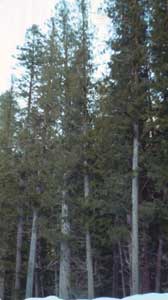
(Western Red Cedar)
[Donn.]
Class: Pinopsida
Order: Pinatae
Family: Cupressaceae
Family Description: Cypress
Key Characteristics:
| Also known as Red, Western Red, Pacific Red, or Giant Cedar. | ||
|
needles
|
cones
|
seeds
|
|
|
|
General Description:
A tree 40-60 m tall with a narrow conical crown and a tapering trunk 1-3 m in diameter and strongly buttressed at the base; branchlets flattened, pendulous, forming flat, front-like sprays; bark bright cinnamon-brown, divided into broad, rounded ridges; leaves on leading shoots ovate, long-pointed, 6 mm long, glandular on the back, while on the lateral shoots they are 3 as long, without glands or these very obscure; cones reflexed, about.
Distribution:
Southern Alaska along the coast, in the Cascade Mountains, to Humboldt County California, east through British Columbia and northern Washington, to southeast British Columbia, northern Idaho (mostly on the west slope of the mountains) and northwest Montana.
Habitat:
Western Red Cedar is found only in areas with abundant rain or snow, high humidity, and cool summers from sea level to 5000 feet elevation. At the higher elevations, they appear more like shrubs than the tall stately trees found at lower elevations. They grow best in river bottoms, swamps, moist ravines and gulches. Best growth is found in deep, rich soils. Rarely found in pure stands, they are commonly found with Coastal Redwood, Sitka Spruce, Western Hemlock, Douglas Fir, Lowland Fir, and Western larch.
Other:
Western Red Cedar wood is aromatic, light, attractive and very resistant to rot, thus is used for siding, shakes and shingles, posts, poles, doors, window sashes, boats, greenhouse benches, canoes, totem poles, and lodges. It has few if any diseases. The strong inner bark was used for making baskets.
Important State References:
No information available at this time
Photos & information written by Dr. Karl E. Holte,© 2002
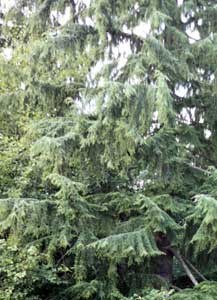
(Western Hemlock)
[(Raf.) Sarg.]
Class: Pinopsida
Order: Pinatae
Family: Pinaceae
Family Description: Pine
Key Characteristics:
| Also known as Western, Pacific, or Lowland Hemlock. | ||
|
branchletes
|
cones
|
seeds
|
|
|
|
|
needles
|
||
|
||
General Description:
A tall, slender tree 50-60 m high, with a narrow pyramidal crown (terminal leader droops, forming an arc) and a trunk diameter 1-2.5 m; bark thick, deeply divide into broad, flat ridges; leaves 2-ranked, 6-20 mm long, with 2 light colored bands of stomata beneath; cones purple, ovoid; scales obovate; seeds about 3 mm long, their wings 2-3 times as long. Moist soil, W, Mont. to Alaska, across N. Idaho to Calif.
Distribution:
Along coastlines from Alaska to northern California and a somewhat separate distribution in southeastern British Columbia, northern Idaho and northwestern Montana.
Habitat:
Western Hemlock tolerates and reproduces in deep shade where it is moist, such as in Northern Idaho and coastal regions, thus from sea level to 7,400 feet elevation. Associate species are Mountain Hemlock, Western White Pine, Douglas Fir, Silver Fir, Coastal Redwood, and Sitka Spruce. Common enemies are Hemlock Dwarf Mistletoe, snow and wind, the latter knock over the shallow rooted trees.
Other:
Birds and rodents eat the seeds and rabbits, beaver, and deer browse on seedlings, saplings, and even large trees. The lightweight wood is hard, tough and is used for building, construction and pulp. The bark was used by native Americans for tanning leather.
Important State References:
No information available at this time
Photos & information written by Dr. Karl E. Holte,© 2002
(Mountain Hemlock)
[Bong.]
Class: Pinopsida
Order: Pinatae
Family: Pinaceae
Family Description: Pine
Key Characteristics:
| Also known as Black Hemlock. | ||
|
needles
|
cones
|
seeds
|
|
|
|
General Description:
A sharp pointed, pyramidal tree, from a few m tall on bleak mt. ridges to 45 m tall at lower elevations under favorable conditions; trunk 5-12 dm in diameter, with thick bark divided into rounded ridges; leaves mostly spreading from all sides of the branches, curved, 15-20 mm long, with stomata on both surfaces; cones oblong-cylindric, yellowish to purplish; scales wedge-shaped; seeds about 3 mm long, with long wings. Mts. W. Mont. to Alaska, across N. Idaho and to Calif.
Distribution:
At elevations of 4000-7000 feet elevation from southern Alaska and western British Columbia to northern California Sierra Nevada mountains to west central Nevada, east to southeastern British Columbia to northern Idaho, northeastern Oregon and western Montana, in Washington in both the Cascade and Olympic Mountains.
Habitat:
Commonly found on subalpine to alpine exposed ridges and slopes along the coast line from southeastern Alaska into Washington and in scattered locations inland in British Columbia, Idaho and Montana, Oregon and Northern California. Mountain Hemlock seems to prefer sheltered, areas with deep, well-drained, but moist soils where the precipitation is high and winters cold. Associate species are Sitka Spruce, Western Hemlock, Subalpine Fir, Red Fir and Lodgepole pine or may occur in almost pure stands.
Other:
The light weight wood is mostly used only when other wood is not available for rough construction. Wildlife value seems limited, but cover is utilized by blue grouse and Douglas Chickarees east the bark, buds and seeds.
Important State References:
No information available at this time
Photos & information written by Dr. Karl E. Holte,© 2002
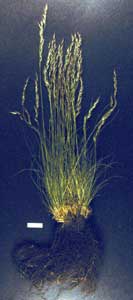
(Idaho Fescue)
[Elmer]
Subclass: Commelinidae
Order: Cyperales
Family: Poaceae
Family Description: Grass
Key Characteristics:
| Is a bunch grass. Appears to be like a bluegrass, but differs in having awns. Culms (stems) hollow. | |||
|
leaves
|
inflorescence
|
spikelets
|
lemmas
|
|
|
|
|
|
palea
|
|||
|
|||
|
florets
|
|||
|
|||
General Description:
Culms usually tufted in large bunches; blades numerous, very scabrous, rarely smooth, filiform, involute; spikelets mostly 5-7 flowered; lemmas nearly terete, about 7 mm long; awn usually 2-4 mm long. This may be only a larger phase of F. ovina. Open woods and dry soil. Alta. To B. C., south to Colo. And Calif. Very abundant in Idaho, and one of the important range grasses.
Distribution:
British Columbia to Alberta south through Cascade and Olympic mountains through Oregon to Sierran
California eastward through Nevada, northward to Colorado, Montana, Wyoming, Montana, Utah and Idaho.
Habitat:
Found in grasslands and sagebrush, dry desert areas up to dry mountain slopes and meadows
Other:
Idaho Fescue is an extremely important forage grass and often disappears with overgrazing
Important State References:
No information available at this time
Photos and Information written by Dr. Karl E. Holte,© 2002
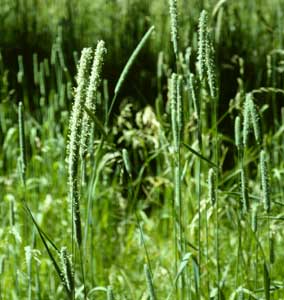
(Timothy)
[L.]
Subclass: Commelinidae
Order: Cyperales
Family: Poaceae
Family Description: Grass
Key Characteristics:
| A bunch grass up to 1 m tall, each stem with a bulbous, hard base | |||
|
leaves
|
inflorescence
|
spikelets
|
lemmas
|
|
|
|
|
|
palea
|
|||
|
|||
|
florets
|
|||
|
|||
General Description:
Culms 50-100 cm tall, from a swollen base, forming large clumps; blades elongate, mostly 5 mm wide; panicle 5-10 cm long, 1 cm or less wide; glumes about 3.5 mm long, truncate, with a stout awn 1 mm long, pectinate-ciliate on the keel. Escaped from cultivation over most of N. Am. This is one of our most valuable grasses for forage.
Similar Species:
Phleum alpinum L.
Distribution:
Throughout the U. S. and southern Canada in moist areas.
Habitat:
An introduced grass which seems to appear wherever horses are grazed and is planted with alfalfa as a hay crop, in waste places, old fields, roadsides and railroad embankments, logging roads where planted to prevent erosion.
Other:
Phleum pratense is an important forage grass and crop plant for hay, particularly for horse feed; originally from Eurasia. A look-alike is Phleum alpinum L. which is a native grass which has shorter, broader, panicles, lacks a bulbous base and is often purplish in the inflorescence.
Important State References:
No information available at this time
Photos and Information written by Dr. Karl E. Holte,© 2002
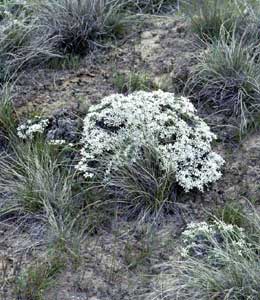
(Hood's Phlox)
[Rich]
Subclass: Asteridae
Order: Solonales
Family: Polemoniaceae
Family Description: Phlox
Key Characteristics:
|
leaves
|
flowers
|
fruit
|
|
|
|
General Description:
A perennial, mat-forming, low-growing shrub with cymose inflorescences of showy flowers which have the family characteristic of a salvariform corolla which may vary from white to purple; the sepals are fused together, but are separated by membranous costae which bulge as keels between them forming an unusual calyx.
Plant pulvinate to cespitose, usually without development of decumbent stems, 2-10 cm high; leaves narrowly to broadly subulate, glabrate to basally tomentose, the larger 3-10 or rarely 12 mm long and 0.5-1 mm wide; inflorescence 1- or rarely 3-flowered, the pedicels short; sepals 4-8 mm long, their costa distinct and junction-membranes flat; corolla-tube 4-10 and petal-blades 3-8 mm long, white to lilac; style 2-6 and stigmas 0.5-1 mm long. Dry rocky or gravelly barrens. C. Wash. to subarctic Can., N. D., W. Neb., northern N. M., and E. Calif.; in the lower vegetation zones of Idaho. Divisible into several entities which have been classed as subspecies, although they intergrade here so extensively that their separation may not be worth-while: canescens (T.&G.) Wherry, with canescent to subtomentose herbage, larger leaves 8-12, sepals 7-9, and corolla-tube 8-10 mm long; genuina Wherry, also pubescent but with the larger leaves 6-8 (rarely 10), sepals 5-7, and corolla-tube 5-8 mm long; glabrata (E. Nels.) Wherry, glabrate with dimensions of parts covering the range of the two preceding, and viscidula Wherry, similar to genuina, but the hairs of the upper herbage finely gland-tipped.
Distribution:
Southern British Columbia south through Washington, to souther California, east to New Mexico and northward through Colorado, Wyoming, Montana, Utah and Idaho.
Habitat:
Dry, open rocky, sagebrush areas from low elevations to sometimes high in the mountains; tends to increase with grazing or other disturbances.
Other:
Although it is an extremely attractive plant in the spring, no uses either by Native Americans or modern day herbalists could be documented.
Important State References:
No information available at this time.
Photos and Information written by Dr. Karl E. Holte,© 2002
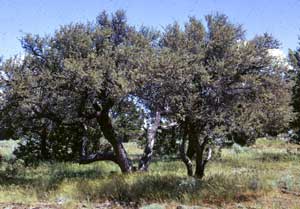
Genus & Species Common Name Family Family Common Name
Cercocarpus ledifolius Nutt. Mountain Mahogany Rosaceae Rose Family
CHARACTERISTICS
Small tree or large shrub up to 25 feet tall and up to 20 inches in
diameter with a rough barked, crooked stem; sometimes forms almost
monoculture stands or mixed with conifers and junipers.
Scraggly, stout, 3-6 m tall; old bark gray, young twigs reddish,
pubescent, but soon glabrate; leaves evergreen, glabrate, pubescent, or
tomentose beneath, 1-3.5 cm long, lanceolate, entire, the margins
somewhat revolute, the. Petioles 3-5 mm long; calyx tube 9-9 mm long,
almost enclosing the body of the achene; the plumose style 5-7 cm long.
Dry ridges, Mont. to Wash., south to Colo., Ariz., ad Calif.
Var. hypoleucus (Rydb.) Peck. Similar to the species, but the leaves
permanently white tomentose beneath and sometimes above, narrower and
more revolute; petioles 1-2 mm long; calyx tube 4-mm long. Mont. to
Wash., south to Wyo., and Nev.
Another species, C. montanus Raf. should be looked for in the state. It
can be readily told by its coarsely toothed ovate to obovate leaves.
leaves
are persistent, revolute margins on a narrow, elliptic blade which is
densely lanate on abaxial surface, more or less glabrate on upper
surface, 1-3 cm long, pointed at both ends; petioles 1-5 mm long
flowers
apetalous, sessile, 1-3 in leaf axils, calyx lanate, recurved lobes of
hypanthium 1.5-2 mm long on a tube 4-7 mm long; 20-30 glabrous stamens
fruit
an achene 5-7 mm long bearing a persistent, plumose style5-8 cm long
habitat
usually rocky soils in desert foothills and mountain sides
distribution
southeastern Washington across Idaho to the Rocky Mountains of Montana
south through western Colorado into northern Arizona west through
southern California through southwestern Oregon
other
The wood of Mountain Mahogany can be so dense that it is said to sink
if freshly cut. Because of its density and strength is was used for
mining timbers, and to make novelties and flutes. It makes excellent
charcoal for cooking and smoking meat. It burns with little smoke and
is said to have been used by crooks for fires that could not easily be
detected because of lack of smoke.
The leaves and twigs are browsed by many animals, especially in winter
when it is still green and other plants have turned brown. Thus it is a
source of vitamins and proteins often lacking in plants in the winter.
The plumose achenes can be used as kindling to start fires.
Photos and content written by Karl Holte, 2002
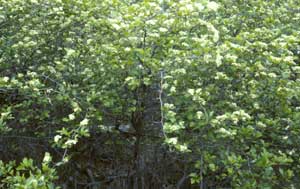
Genus & Species Common Name Family Family Common Name
Crataegus douglasii Lindl. Black Hawthorn Rosaceae Rose Family
CHARACTERISTICS
CRATAEGUS L. Hawthorn.
Large shrubs or small trees, usually with thorns; leaves alternate,
simple, serrate to shallowly lobed; flowers few, usually white, in
terminal corymbs; calyx 5-lobed, the tube campanulate to cup-shaped;
petals 5, rounded; stamens 5-many; ovary inferior, of 1-5 carpels;
fruit, globose or ovoid.
Fruit red; leaves pubescent at least beneath; thorns 3-6 cm long… C.
columbiana.
Fruit black or nearly so; leaves glabrate or nearly so; thorns usually
1.5-3cm long.
Leaf blades serrate and lobed toward the apex, obovate to broadly
ovate, almost as broad as long; spines stout… C. Douglasii.
Leaf blades finely serrate, sometimes irregularly so, elliptic to ovate
lanceolate, almost twice as long as broad; spines slender… C.
rivularis.
C. Douglasii Lindl. Usually a small tree up to 10 m tall, with stout
spines 8-20 mm long, and glabrous twigs; leaf blades 3-8 cm long, Pale
beneath; rimes glabrous; calyx lobes ovate to oblong, often retire,
pubescent within; fruit globose, 6-10 mm 1. diameter, glabrous. Moist
Soil. Mont., to B. C., south to Idaho and Calif.
This small tree or large shrub is common in moist areas such as stream
banks and is commonly found with chokecherry. It usually grows in dense
colonies. In other areas, it is associated with Ponderosa Pine, Douglas
Fir, Grand Fir-Hemlock, and in ecotones between forest and grasslands.
Sometimes it is found in disturbed forest areas.
leaves
the blades are commonly 3-6 cm long and about as broad as long. While
sometimes simply serrate, they are usually doubly serrate or lobed with
serrations. They are generally obovate in shape. The petioles are
usually about 1/3 the length of the blade.
flowers
The ovary is inferior; the hypanthium varies from glabrous to
pubescent; the sepals are reflexed, triangular in shape, and about
1.5-2.5 mm long. The nearly orbicular white petals are about 5-7 mm
long. The stamens vary from 10-20. There are normally 5 styles.
fruit
The 1 cm, glabrous pome is dark maroon to blackish.
habitat
Black Hawthorn is usually associated with streams, but can also form
dense colonies in moist areas on mountainsides, under Ponderosa Pine or
Douglas Fir in natural or disturbed areas, or along moist roadsides.
distribution
From southern Alaska south to California on both sides of the cascades,
east to Alberta
southward through North and South Dakota to Colorado, Utah, and eastern
Nevada.
other
This a vicious, thorned bush which both people and cattle usually
avoid. Because of this it provides good cover for small mammals and
birds. The pomes are eaten by birds and bears. They make a pretty
tasty jelly even though while raw, they are rather dry and bland.
Porcupines often spend large portions of winters in Black Hawthorns
eating off the bark.
This species is sometimes divided into subspecies or varieties or into
separate species based on leaf size and shape and length of thorns.
Photos and content written by Karl Holte, 2002

Largeleaved Avens, Oregon Avens

Gland Ocean Spray
(Mallow Ninebark)
[Kuntze (Greene)]
Subclass: Rosidae
Order: Rosales
Family: Rosaceae
Family Description: Rose
Key Characteristics:
| The bark peels or shreds, thus the name, Ninebark. | ||
|
leaves
|
flowers
|
fruit
|
|
|
|
General Description:
A small shrub 0.5-2 M tall with glabrous to stellate hairy twigs of drier woodlands east of the Cascade range. The bark peels or shreds, thus the name, Ninebark.
Distribution:
South central British Columbia east through southwest Alberta southward through central Washington, eastern Oregon east of the Cascade Mountains, Montana, Wyoming, Idaho and Utah.
Habitat:
Moist slopes, along streams, and moist woods, Ponderosa Pine and Douglas Fir woodlands and canyon bottoms; associates are aspen, and mixed conifer stands in elevations from 1600 to 3300 meters.
Other:
This plant is sometimes cultivated where water is a limiting factor. Other than incidental browsing by big game, no uses are reported.
Photos and Information written by Dr. Karl E. Holte,© 2002
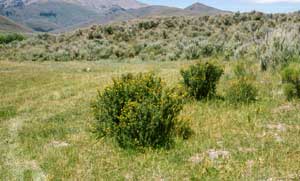
Shrubby Cinquefoil, Yellow Rose
(Antelope-brush)
[(Pursh) DC.]
Subclass: Rosidae
Order: Rosales
Family: Rosaceae
Family Description: Rose
Key Characteristics:
| Also known as Bitter-brush | ||
|
leaves
|
flowers
|
fruit
|
|
|
|
General Description:
A freely branched shrub commonly 1-2 M tall, but rarely up to twice that tall: commonly associated with sagebrush which it resembles, but blooms in the spring with beautiful, yellow petaled flowers instead of fall as sagebrush does with non-showy flowers. Antelope-brush has darker green leaves.
Distribution:
East of the Cascades from British Columbia southward through Washington, Oregon into California as far south as Inyo County east through Utah into Colorado and northward through westernWyoming, and Montana.
Habitat:
Grasslands, deserts, dry areas with sagebrush, junipers and Ponderosa Pine.
Other:
Antelope Bitter-brush is an excellent browse plant for deer, elk, moose, antelope and domestic cattle. In overgrazed areas, it is planted by governmental agencies, boy scouts and other volunteer groups. It can be grown from either sprouts or seeds. Any Homo sapiens who tastes it usually comments that it is difficult to understand how this species can be a favorite food of so many animals.
Important State References:
No information available at this time.
Photos and Information written by Dr. Karl E. Holte,© 2002
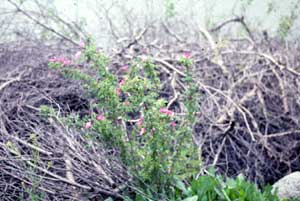
Wood's Rose
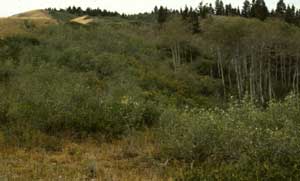
Rocky Mountain Ash
Spiraea betulifolia Pall. Shiny-leaf Spiraea or Spirea Rosaceae Rose
Family
CHARACTERISTICS
These understory, deciduous, rhizomatous shrubs with toothed, sometimes
shallowly-lobed, ovate leaves are usually about knee high, but can be as
much as a meter tall. The leaves are usually coarsely doubly serrate,
sometimes appearing almost lobed.
leaves
The ovate or obovate leaves have a dark green upper surface with a more
pale lower surface. They are commonly 2-7 cm long, doubly serrate and
sometimes slightly lobed.
flowers
in nearly flat-topped, fuzzy appearing (because of the exerted
stamens) corymbs 3-8 cm long; individual flowers small, 1-1.5 mm wide
hemispheric hypanthium; petals are off-white, sometimes with a pinkish
or lavender tinge: Stamens 25-50, exerted; five free pistils each with a
terminal, slender 1.5-2 mm long style terminated by a capitate stigma.
fruit
a leathery follicle about 3 mm long glabrous except for the ciliolate
suture; fusiform seeds 2-numerous in each follicle lacking endosperm at
maturity.
habitat
understory plants in moist woodlands, moist streambanks and around
standing water, sometimes in talus slopes,
distribution
British Columbia southward to north central Oregon, up to 4000 feet
elevation in the Cascade Mountains, eastward up to 11,000 feet elevation
inland eastward to Sask , south to South Dakota and westward through
Wyoming, and Idaho; Also found in Asia.
other
These plants are usually free of insect problems and diseases. No uses
could be found.
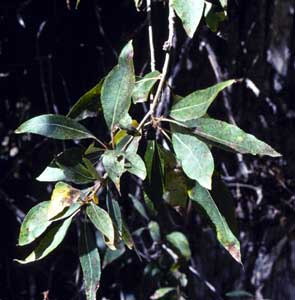
Narrow-leaved Cottonwood
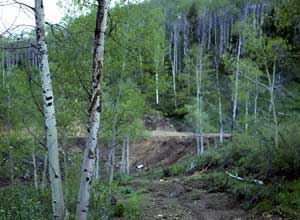
Quaking Aspen
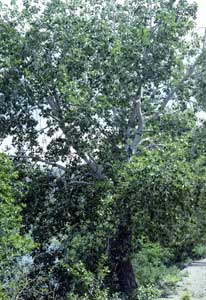
Black Cottonwood
(Merten’s Saxifrage)
[(Pursh) DC.]
Subclass: Rosidae
Order: Rosales
Family: Saxifragaceae
Family Description: Saxifrage
Key Characteristics:
| Also known as Wood Saxifrage | ||
|
leaves
|
flowers
|
fruit
|
|
|
|
General Description:
Herbaceous perennial arising from short stout rhizomes forming clumps; the 1.5-4 dm tall pubescent, purplish-glandular flowering stems are succulent and often brittle.
Distribution:
Southern Alaska southward to northwestern California and central Sierra Nevada from the Cascade mountains to the Pacific Coast eastward through British Columbia to northwest Montana southwestward through cental Idaho and northeastern Oregon.
Habitat:
Merten’s Saxifrage grows at lowland elevations up to montane communities. It is usually found in moist places such as stream banks.
Other:
There is much variability within this species, some having some flowers replaced by pink bulblets and others having only flowers with no bulblets.
Important State References:
No information available at this time.
Photos and Information written by Dr. Karl E. Holte,© 2002
Taxus brevifolia Nutt. Western or Pacific Yew.
These are trees ranging in height from 5 to 10 meters tall. The erect trunks can be either straight or contorted. The outer, purplish scaled bark is thin. The inner bark is reddish purple. The flat , yellow-green leaves remain alive up to 6 years. They are about ½ to 3/4 inches long and up to 1/8 inch wide and end in a small projecting point (mucronate). In northern Idaho they grow in moist forests, especially along streams.
Genus & Species Common Name Family Family Common Name
Taxus brevifolia Nutt. Western or Pacific Yew Taxaceae Yew Family
CHARACTERISTICS
Taxus brevifolia Nutt. Western Yew. A shrub or small tree, sometimes
up to 20 meters tall, mostly found as understory in coniferous stands;
bark scaly; leaves 1-2 cm long, yellowish-green, paler beneath,
slender-petioled, linear, flat, with strong midrib, spinulose-tipped;
see ovoid, 5-6 mm long, 2-4-angled; aril a translucent red cup, 4-5 mm
broad. Mts., Alberta to Alaska, south to Montana., across northern and
western Idaho to California.
leaves
Although the dark yellowish green needles are arranged in a spiral on
the twigs, they spread and become two ranked. They vary in length from
1.2 to 2.6 cm long. They are usually straight and flat and have a
pointed tip.
cones
The 6-14 staminate cones are clustered into a spherical-shaped
cluster. The seeds are surrounded by
an outgrowth of the seed stalk called an aril. The red aril surrounds
the seed except at the end where the shiny black seed can be seen in the
cavity.
Seeds
The dark, hard seed is 6-8 mm long and is single, erect, and broadest
near the base with a pointed tip.
habitat
stream margins, moist flats and ravines from 2100 to 8000 feet
elevation as a scattered, understory tree in coniferous forests with
such species as Douglas Fir, Grand Fir and Coastal Redwoods.
distribution
Alaska southward to northern California and inland in a separate
population in eastern Washington Oregon and in the panhandle of Idaho
with two separate small populations in northeastern Oregon and south
central Idaho.
other
Western Yews regularly produce large seed crops. Birds readily eat the
bright red aril covered seed, digest off the aril and then defecate the
seeds, thereby scattering them around the forest. Because the leaves
are poisonous to mammals, they avoid eating the twigs and leaves.
The wood is light red or rose-colored, hard, ehavy, stgrong, durable,
fine-grained and resilient. It is used for making canoe paddles,
archery bows, and handles. It also can be turned in lathes and will
polish nicely.
